Early Views of North Main Street
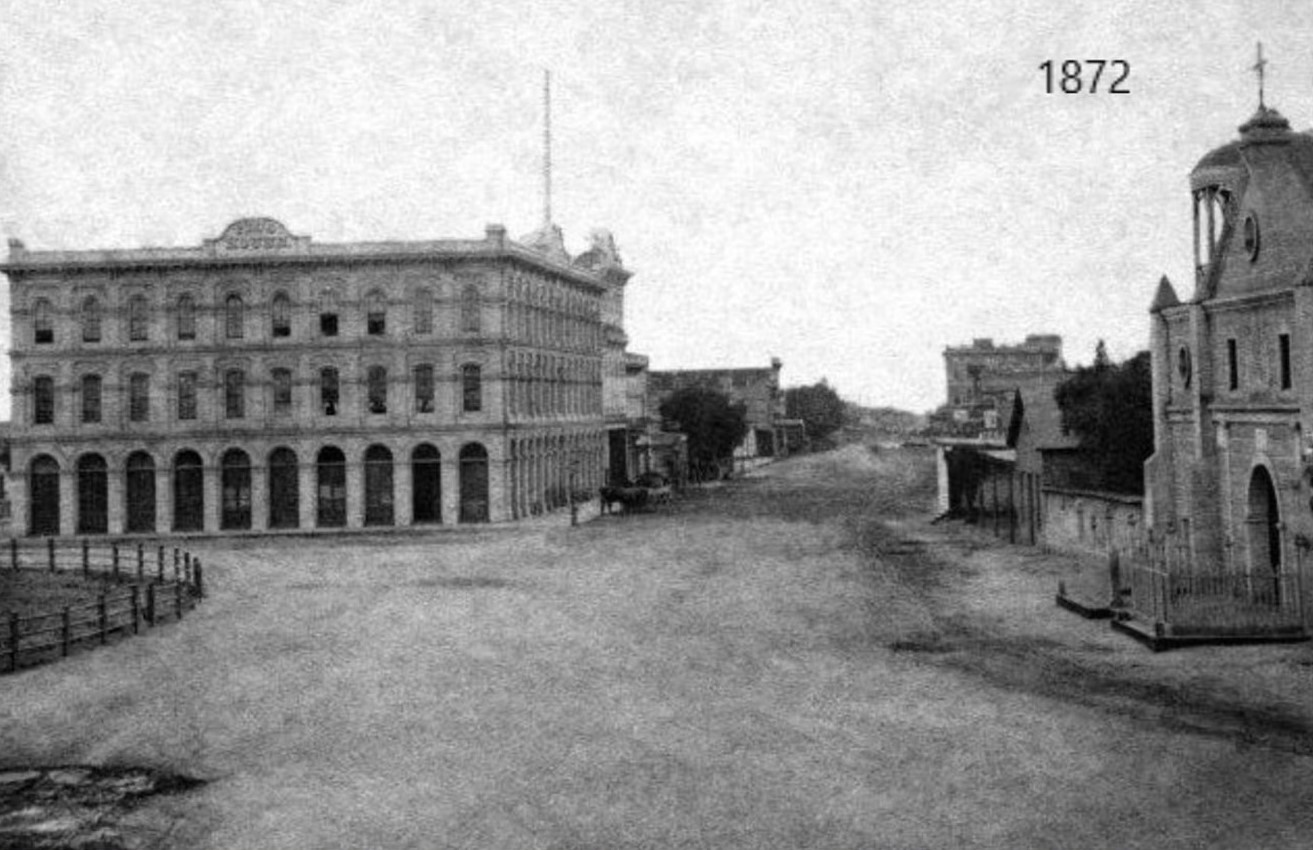 |
|
| (1872)* - Looking south on North Main Street from the edge of the Los Angeles Plaza, this early view captures the city’s main artery lined with its first brick landmarks. The Pico House and Merced Theatre rise to the left, while the distant Temple Block anchors the southern end of the street where City Hall stands today. Click HERE to see a Then and Now comparison of the above scene. |
Historical Notes In this view, the vantage point is just in front of the Old Plaza Church, looking down North Main Street toward what would become the civic and governmental core of Los Angeles. The three major buildings that anchor this scene—the Pico House, Merced Theatre, and Temple Block—represent Los Angeles' first substantial masonry structures and speak to the city’s transformation from a dusty frontier pueblo into a formal American municipality after 1850. The Pico House, built in 1869–70 by Pío Pico, was the most luxurious hotel in Southern California at the time. Just behind it, the Merced Theatre, completed in 1870 by William Abbott, was Los Angeles’ first dedicated theater building and a sign of the city's cultural aspirations. In the distance, the Temple Block (where City Hall now stands) was a cluster of structures associated with Jonathan Temple and later his nephew, F.P.F. Temple—key figures in the development of Los Angeles’ early commercial infrastructure. This image captures the transitional moment between Mexican-era Los Angeles and the booming, railroad-connected American city it was about to become. |
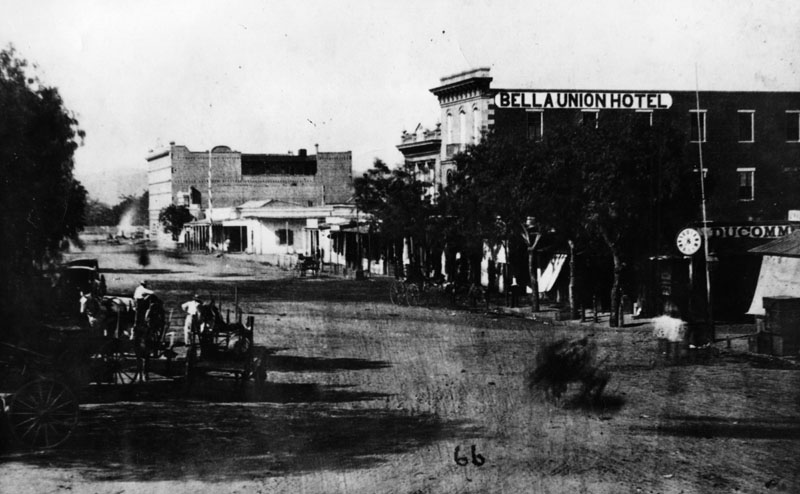 |
|
| (1870)* - Early view of the 300 block of North Main Street and beyond (view is looking North). Two large buildings stand out; the Pico House on the left and the Bella Union Hotel on the right. The Pico House is located one block north, across the street from the Los Angeles Plaza. It was built in 1870 by Pio Pico, the last Governor of Alta California under Mexican rule. Click HERE to see a Then and Now comparison of the above scene. |
Historical Notes This north-facing view from just south of the Plaza provides an excellent look at two of Los Angeles' most iconic early hotels: the Bella Union on the right and the Pico House on the left. These establishments were more than lodging—they were nerve centers of commerce, governance, and public life. The Bella Union Hotel originated as an adobe residence in the 1830s. After serving as a headquarters for U.S. troops during the Mexican-American War, it transitioned into a hotel that hosted judges, legislators, and businessmen. For years, it was the de facto gathering spot for political debate and social events. From 1858 on, it was also a key terminus for the Butterfield Stage, helping to connect Southern California to the rest of the country via mail and passengers. To the left, the Pico Building (built 1868, not to be confused with the later Pico House) housed the Farmers and Merchants Bank, founded by Isaias W. Hellman and endorsed by Pico himself. The arrival of this bank marked a milestone in the city's financial maturity and would grow into one of the major banking institutions in California. This stretch of North Main Street was arguably the most important block in Los Angeles during the 1860s and 1870s—dense with commerce, communication, and political activity. |
 |
|
| (1871)* - A 4th of July parade on North Main Street of the Veterans of the War of 1812. Men are seen in two lines standing in the street, horses and carriages waiting and people on the sidelines. The Bella Union Hotel in the background is partially obscured by trees. |
Historical Notes The Bella Union Hotel was considered the first hotel in Los Angeles. In the 1840s, a one-story adobe owned by Benjamin Davis Wilson stood there. It later became the last capitol of Mexican Alta California. The building served as quarters for American troops in the late 1840s, a saloon, a courthouse (LA's 1st), and a commercial coach hub operated by Phineas Banning. In 1851, a second story was added, and a third in 1869. The area in front of the the Bella Union Hotel was long used as a social and political center. Here, on October 7, 1858, the first Butterfield Overland Mail stage from the east arrived 21 days after leaving St. Louis. Warren Hall was the driver, and Waterman Ormsby, a reporter, the only through passenger. The Bella Union Hotel became the Clarenden Hotel in 1873 and the St. Charles Hotel in 1875. Pico's Building, to the left, was the original home of Farmers and Merchants Bank (later merged into Security Pacific Bank). The Bella Unioin Hotel site was designated California Historical Landmark No. 656. |
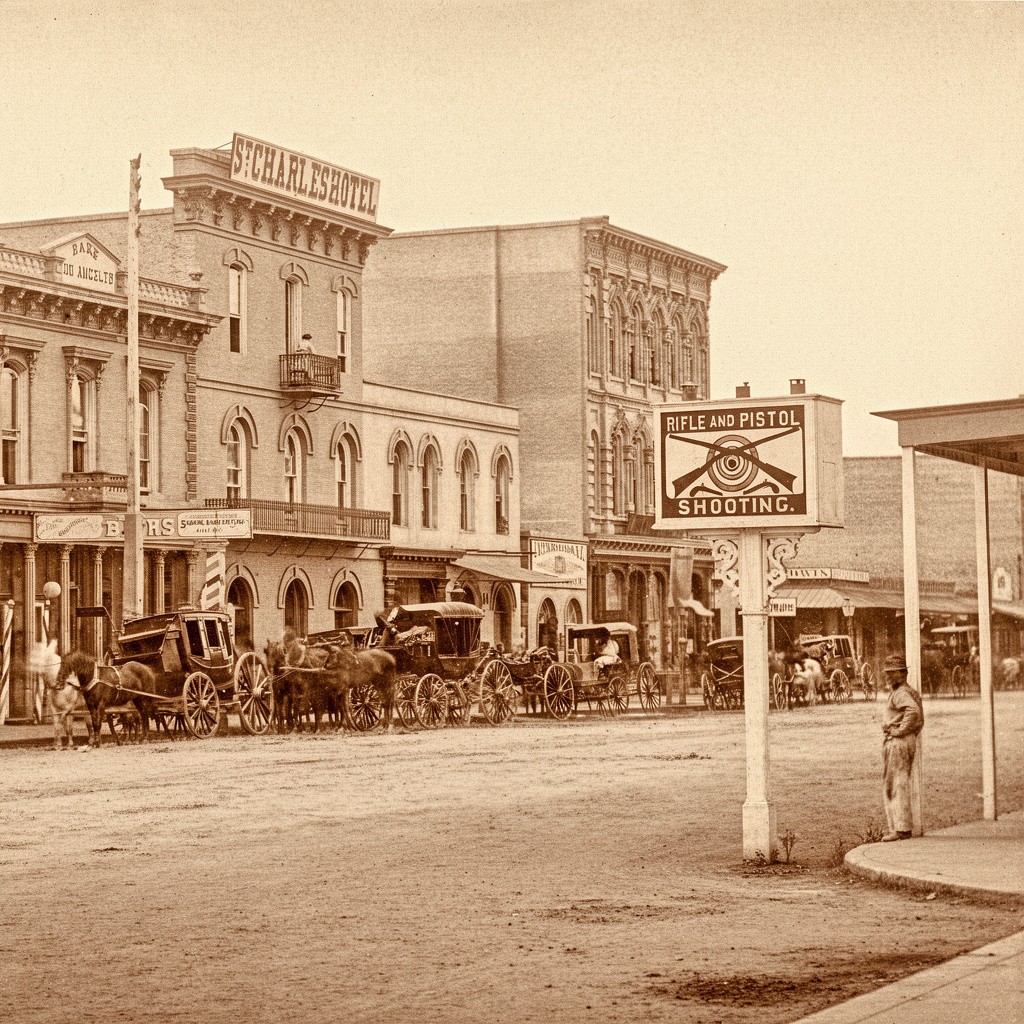 |
|
| (1877)* - View looking across Main Street toward the St. Charles Hotel (previously the Bella Union Hotel). Horse-drawn wagons are parked in front. A man on the right side of the image leans against a post next to a small sign advertising “Rifle and Pistol Shooting.” |
Historical Notes This photograph was taken from directly across Main Street and gives a clear, head-on view of the St. Charles Hotel. The scene shows the everyday business activity of the block with wagons, deliveries and pedestrians. The man leaning on the post and the small shooting gallery sign are details often missed in later views. The St. Charles Hotel retained much of the earlier Bella Union structure, which began as an adobe residence in the 1830s. By the 1870s, it stood as one of the city’s oldest continuously used commercial buildings. This portion of Main Street was a center of activity in the 1870s, with hotels, banks and small storefronts serving travelers, merchants and local residents. |
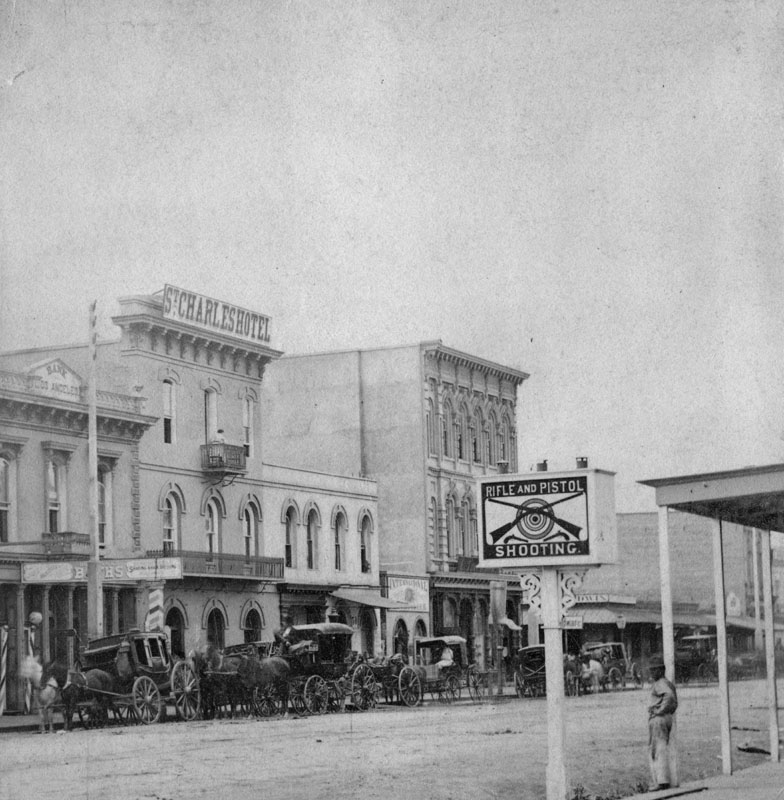 |
|
| (1877)* - View looking southeast showing St. Charles Hotel, originally the Bella Union Hotel. Horses and buggies are lined up along the street. In the foreground a sign reads, “Rifle and Pistol Shooting,” a reminder that Los Angeles was a Western frontier town. |
Historical Notes In the 1870s, downtown Los Angeles, including Main Street, was a place where gun violence and regulation coexisted. The city, with a population of nearly 6,000, had a higher homicide rate than New York or Chicago. Most men walked the streets armed with pistols and knives, and it was said that a murder occurred every day in the city. However, gun control laws were also present in early Los Angeles. Like many towns in the Old West, Los Angeles had regulations on carrying firearms within city limits. Typically, visitors were required to leave their weapons with a law officer upon entering town, receiving a token to reclaim them when leaving. Carrying any kind of weapon, including guns and knives, was generally not allowed within town borders, except inside homes. |
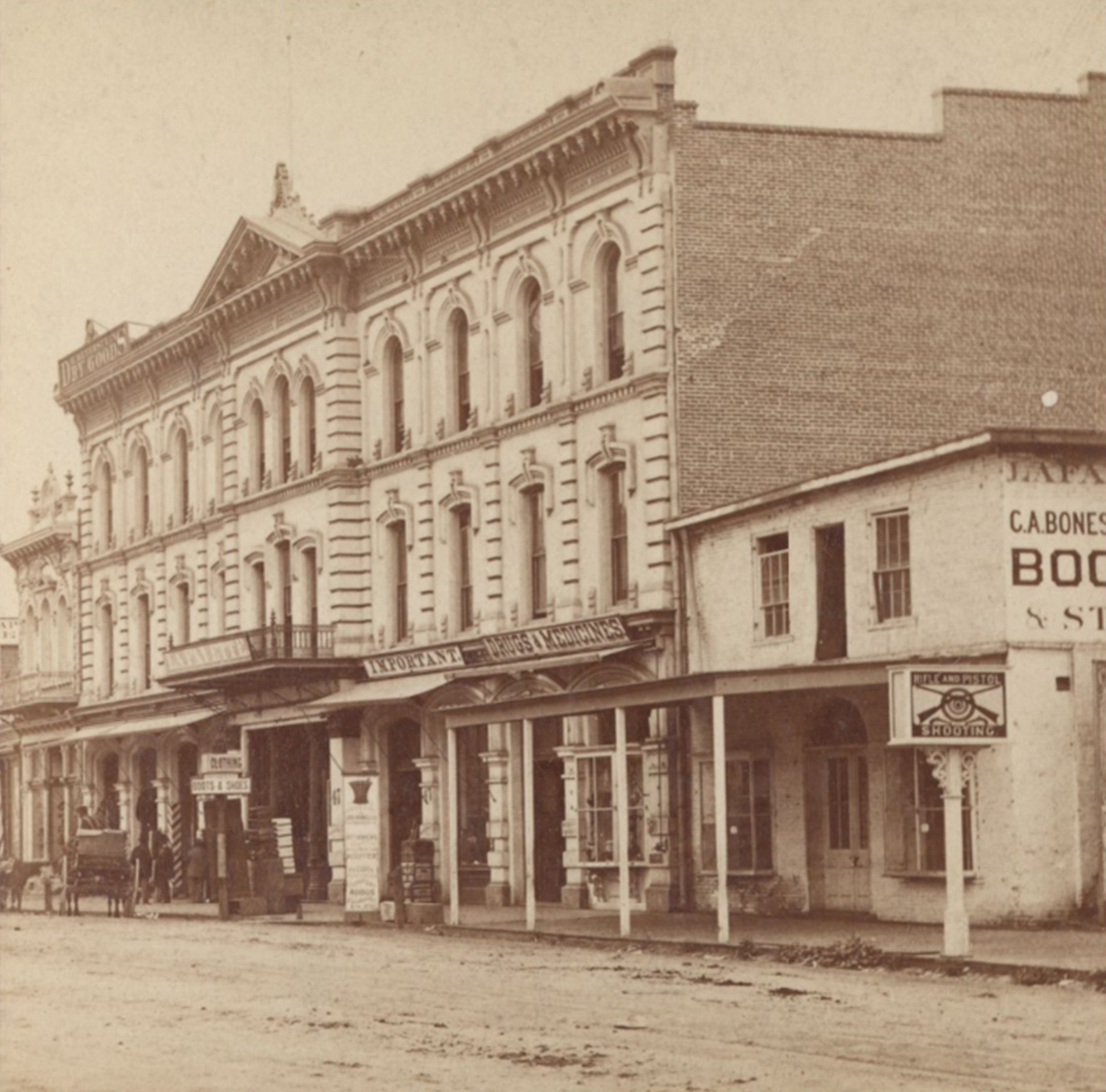 |
|
| (1877)* – View of the Lafayette Hotel, on the west side of Main Street opposite the St. Charles Hotel. The sign at right reading “Rifle and Pistol Shooting” advertises Brulon & Loiseau’s Shooting Gallery. |
Historical Notes The Lafayette Hotel was built in the early eighteen fifties and soon became one of the leading hotels in early Los Angeles. Over the years it carried several names, including the Cosmopolitan and later the St. Elmo, but longtime residents continued to associate it with its original name. The hotel stood just north of Main and Temple and served travelers, merchants and residents during a time when the city was shifting from an adobe settlement to a more structured commercial center. Architecturally, the Lafayette was one of the earliest Italianate style buildings in Los Angeles. This style is seen in its tall arched windows, strong vertical lines, evenly spaced pilasters and the deep cornice supported by decorative brackets. These features gave Main Street a more polished appearance that contrasted with the simpler buildings around it. The shooting gallery sign at the right highlights the mix of entertainment, lodging and small business that once defined this busy block. Today the site is part of the Civic Center near City Hall, and none of the original structures remain. |
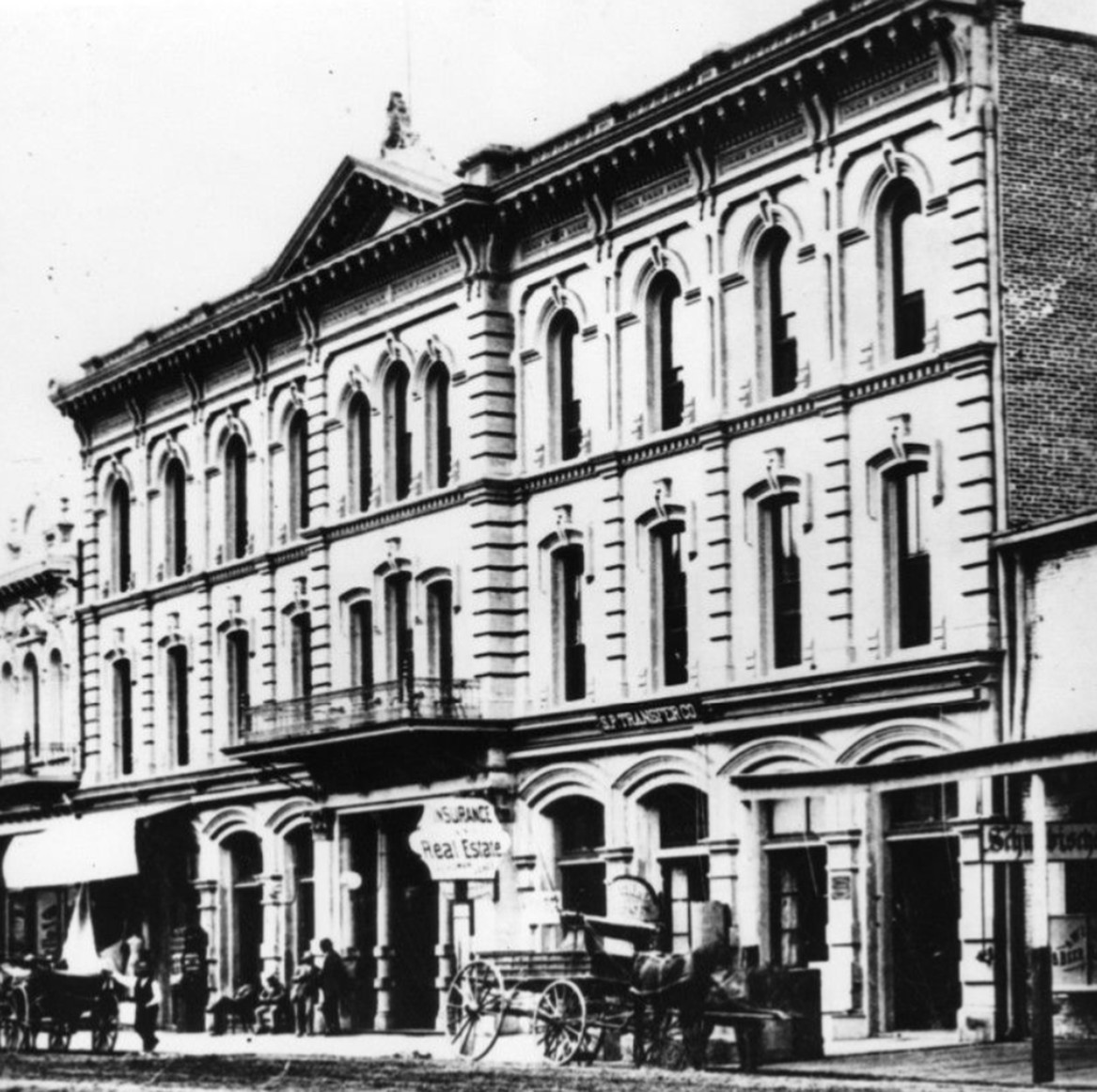 |
|
| (ca. 1880)* - Closer view of the Lafayette Hotel. Several men sit and stand in front of the hotel entry way. The street is unpaved and two horses and carriages are seen in front of the building, one near the Insurance and Real Estate sign. |
Historical Notes This closer view shows the Lafayette Hotel after more than two decades of service and during a period when it was sometimes called the Cosmopolitan and later the St. Elmo. The scene in front, with men gathered near the entrance and carriages waiting at the street, reflects the steady movement of travelers and business activity that made this section of Main Street an important center for the growing town. The Italianate style of the Lafayette is especially clear in this view. The hotel’s brick walls, tall arched windows, iron balcony railings and strong bracketed cornice were all hallmarks of this popular mid nineteenth century style. These features brought a sense of permanence to a city that still had unpaved streets and wooden sidewalks. Within a few decades this entire block was replaced by public buildings, and the Lafayette site became part of the modern Civic Center landscape. |
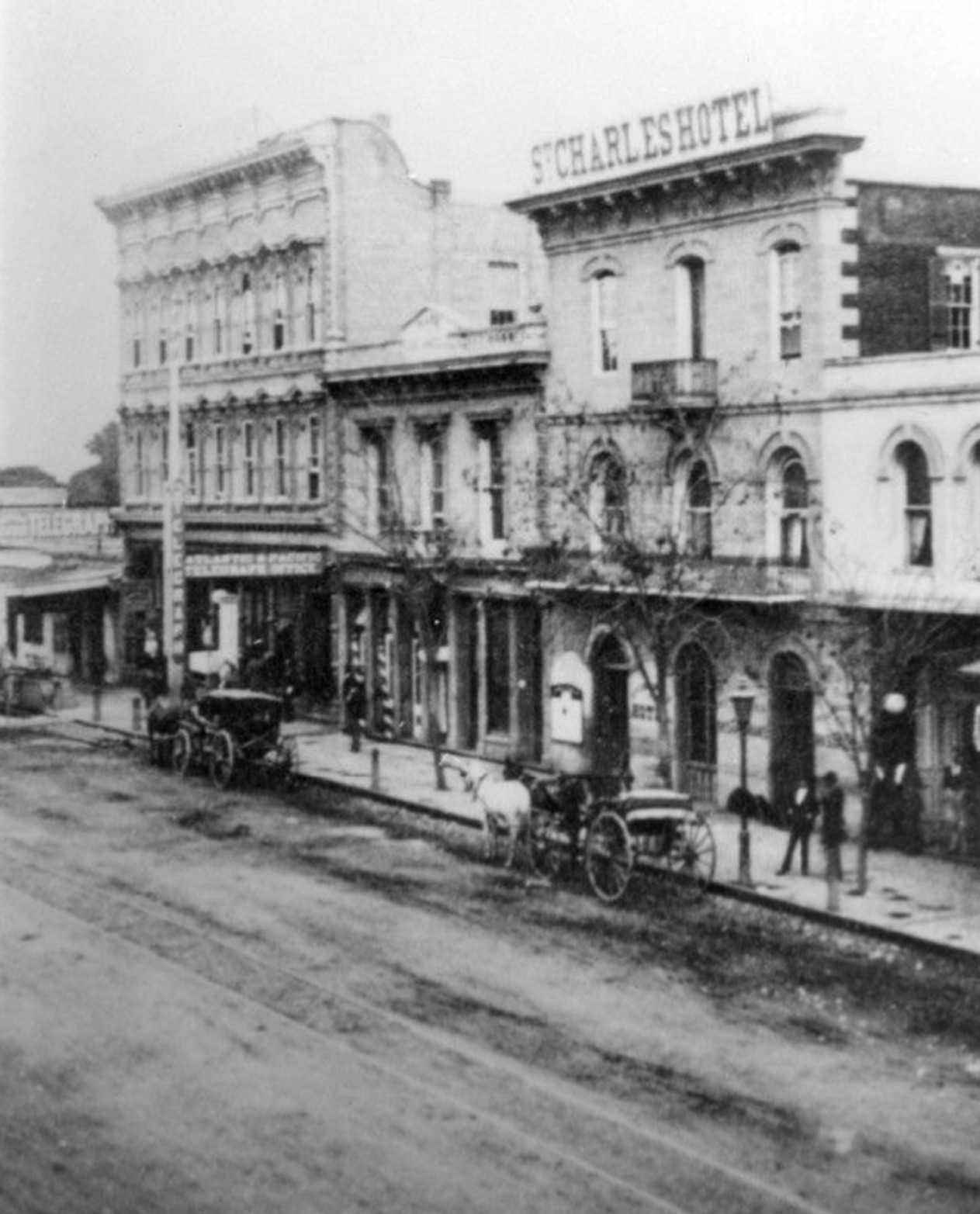 |
|
| (1880)* - View looking northeast showing the St. Charles Hotel, originally the Bella Union Hotel. To the left (north) stands the Farmers and Merchants Bank (previously the Pico Building). Further north is the 3-story Grand Central Hotel, built in 1876. |
Historical Notes The two-story building to the north of the St. Charles Hotel (seen above) is the Pico Building, built by Pio Pico in 1868 (two years before the Pico House). In 1871, the building became home to the Farmers & Merchants Bank, the first incorporated bank in the Los Angeles, directed by former California Governor John G. Downey. In 1871, Isaias W. Hellman and John G. Downey formed the Farmers and Merchants Bank, which became Los Angeles' first successful bank. Hellman lent the money that allowed Harrison Gray Otis to buy the Los Angeles Times and Edward Doheny and Charles Canfield to drill for oil. |
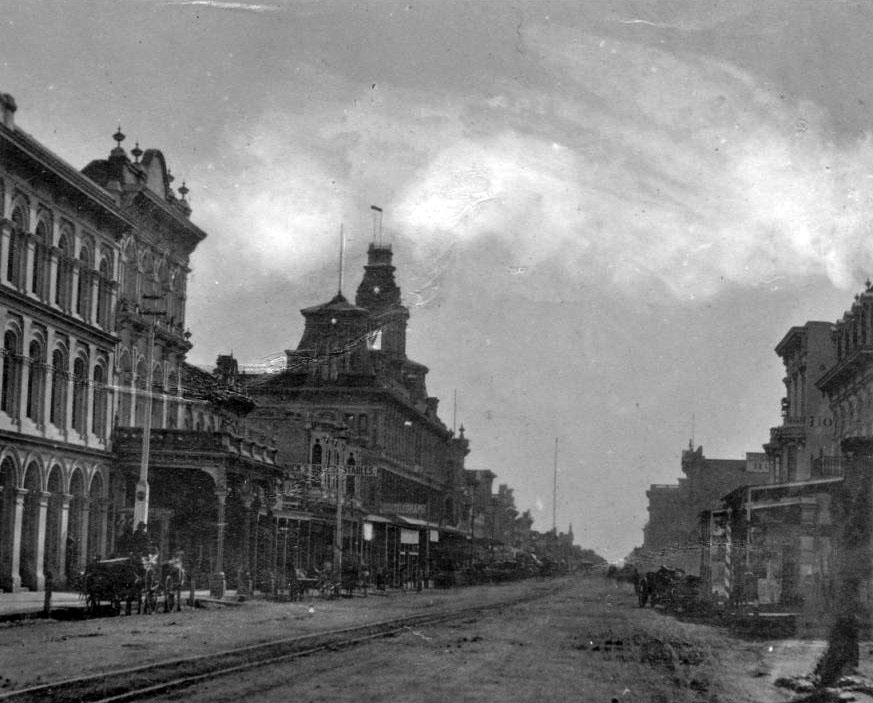 |
|
| (ca. 1878)* - View of Main Street looking south from near the LA Plaza. A horse-drawn wagon with two men in it is parked in front of the Pico House near the Merced Theater on the left. The road is unpaved and a streetcar track runs down the middle. Both sides of the street are lined with imposingly large buildings. At center, on the left side of the street, is an especially large building topped by three prominent towers. It is the Baker Building (referred to as Baker Block), built in 1878. |
Historical Notes The ornate three-story Baker Block was completed in 1878 by Colonel Robert S. Baker. It was located at the north end of the 300 Main St. block at the southeast corner of Main and Arcadia streets. For a number of years, the building housed offices, shops, and apartments. As a point of interest, Colonel Robert Baker married Abel Stearn’s widow, Arcadia Bandini de Stearns, in 1874 (three years after Stearn’s death in 1871). The Baker Block was built on the same site as the Stearns Adobe. |
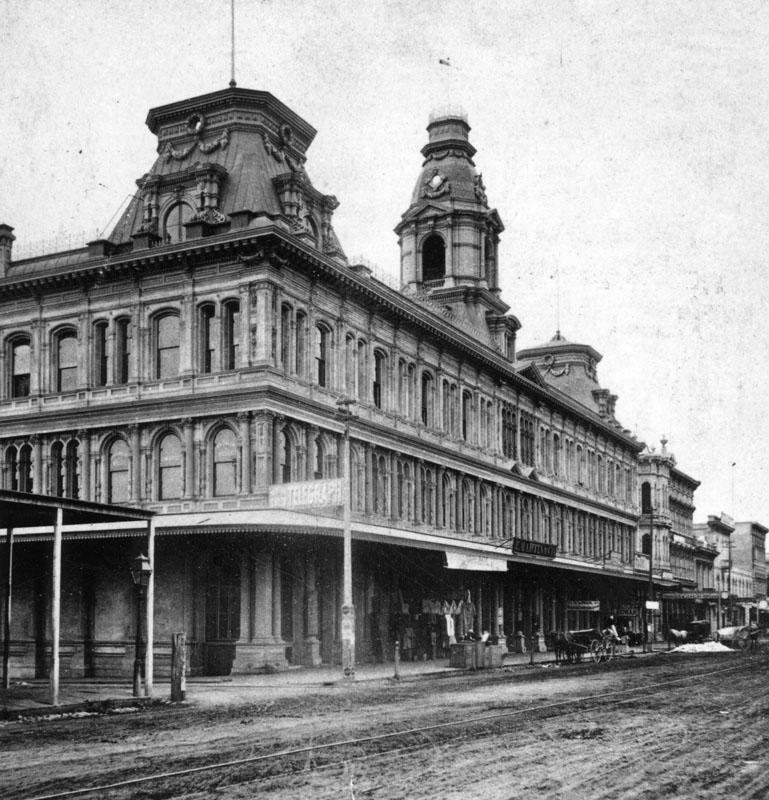 |
|
| (1880)* - Built on the former site of the Abel Stearns Adobe (S/E corner of Main and Arcadia streets) , the Baker Block was prominent in early Los Angeles. Note the telegraph office has a sign at the corner of the building. |
Historical Notes At the time of its completion, the Baker Block was reputedly the largest and most expensive structure to have been built south of San Francisco. Among other achievements, it is also believed to have been Los Angeles’ first steel-framed building, and it's first to have tiled floors. For many years it was considered the best thing in town, an early microcosm of city life. Offices for lawyers, physicians and businessmen were on the second floor and on the top floor were the City's most costly and fashionable apartments. |
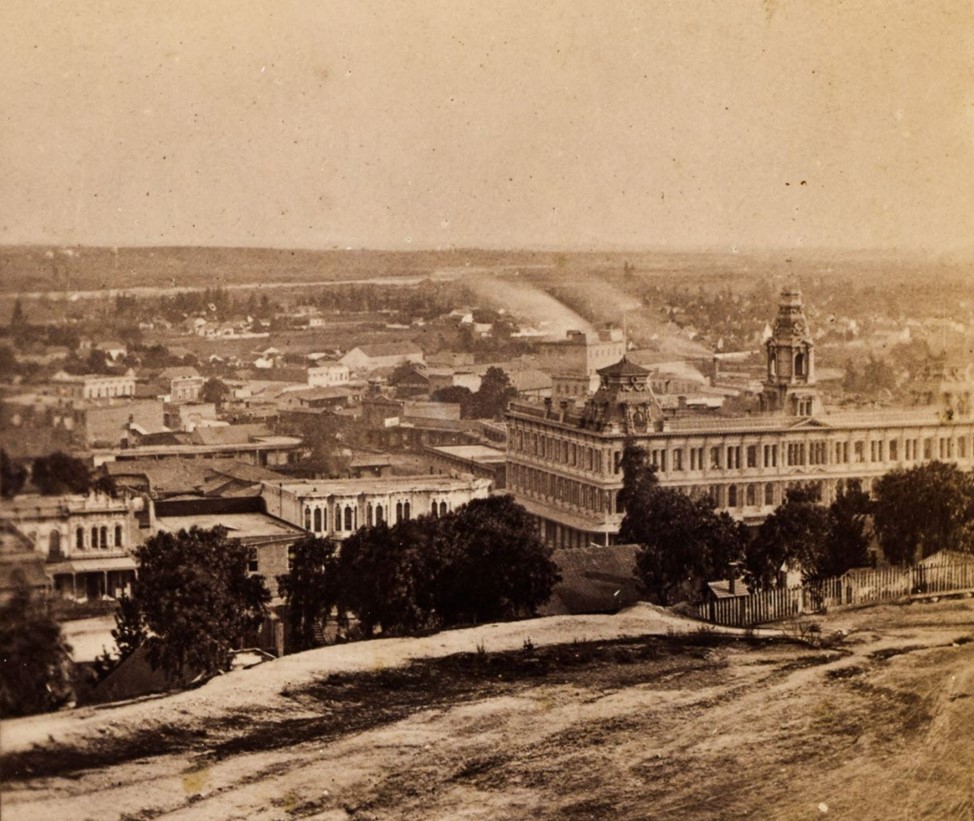 |
|
| (1880s)* - View looking southeast from Fort Hill, with the Baker Block seen on the southeast corner of Main and Commercial Streets. The Los Angeles River is visible in the distance at the upper left. Photo from the Ernest Marquez Collection. |
Historical Notes This elevated view was taken from the slope of Fort Hill, the site later occupied by the County Courthouse and Hall of Records. The Baker Block dominates the intersection of Main, Arcadia and Commercial Streets and was one of the most prominent commercial buildings in early Los Angeles. The Los Angeles River can be seen in the distance. Before flood control projects altered its course, the river flowed close to the early business district. The cluster of buildings between Main Street and the river shows how the commercial district was expanding during the late 1870s and early 1880s. This photograph illustrates the importance of the Baker Block and the businesses surrounding it, which together formed the core of the city’s commercial activity during this period. |
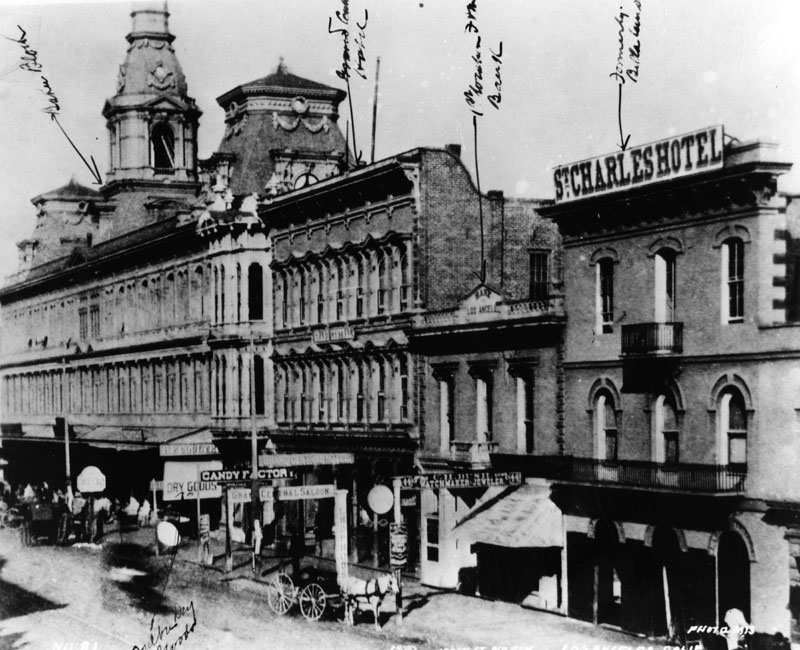 |
|
| (ca. 1880)* - View of North Main Street showing (from L to R): Baker Block, Downey Building, Grand Central Hotel, Pico Building (original home of Farmers and Merchants Bank), and the St. Charles Hotel (formerly the Bella Union Hotel). |
Historical Notes The three-story Grand Central Hotel at 326 North Main Street was completed around 1877. Major construction came to its climax on the 300 blk of Main Street in the following year with the opening of the Baker Block, on the left. The slim, three-story building nestled between the Baker Block and Gand Central Hotel was developed by the ever active Governor Downey, and finished around 1878. |
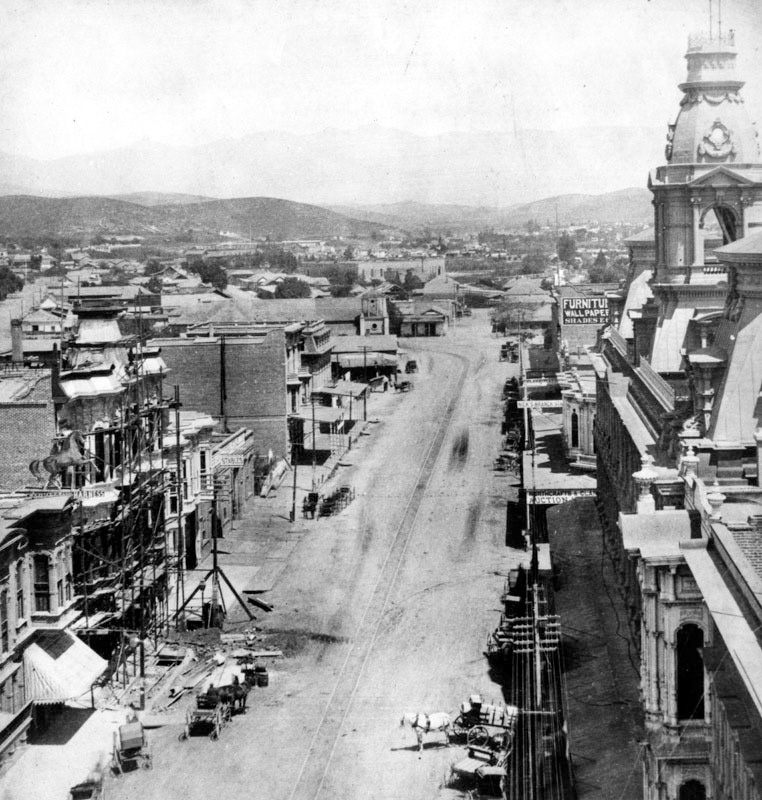 |
|
| (ca. 1880)* - View looking north on Main Street from the Downey Building located just south of the Baker Block on the 300 block of N. Main Street. In the distance can be seen the Old Plaza Church where Main Street veers to the left. Telephone/telgraph lines can be seen on both sides of the street. |
Historical Notes This photograph shows the early spread of telegraph and telephone lines along Main Street. In 1879, the Los Angeles Telephone Company was established, and Main Street became the center of the city’s growing communications network. The unpaved street, the streetcar rails and the horse-drawn vehicles reflect the transitional nature of downtown Los Angeles before widespread pavement and electric streetcars arrived in the 1880s. At the far end of the street, the Old Plaza Church marks where Main Street curves toward the Plaza. This is one of the earliest images to document Los Angeles’ adoption of modern communication systems. Alexander Graham Bell invented the telephone in the late 1870's and it didn't take long for Los Angeles to adopt the new technology. In 1879, the Los Angeles Telephone Company was formed and it began offering telephone service in the area of what is now Downtown Los Angeles. This was just one year after the very first North America telephone exchange was installed in New Haven, Connecticut (January, 1878). The Los Angeles Telephone Company originally started with only seven subscribers. |
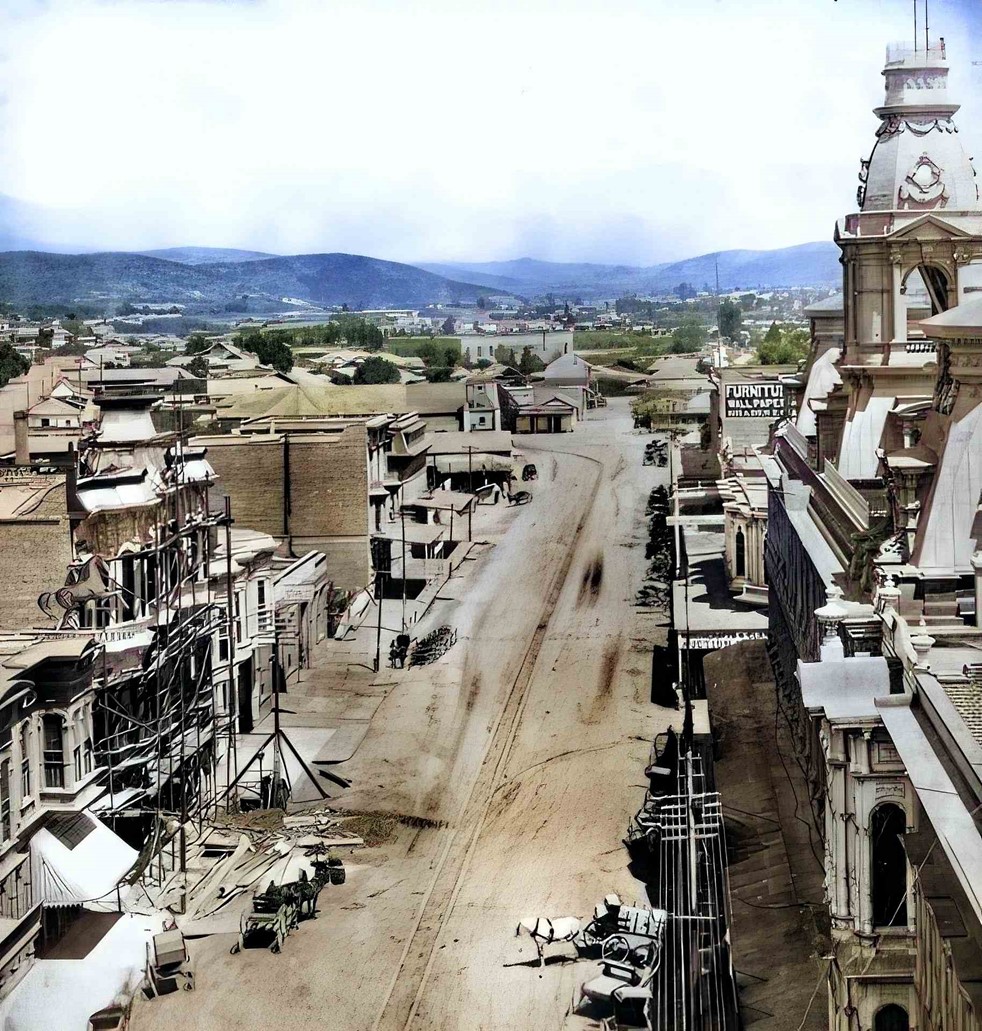 |
|
| (ca. 1880)* - View looking north on Main Street from the Downey Building located just south of the Baker Block on the 300 block of N. Main Street. In the distance can be seen the Old Plaza Church where Main Street veers to the left. Telephone/telgraph lines can be seen on both sides of the street. (AI image enhancement and colorization by Richard Holoff) |
Historical Notes This colorized view brings out details not easily seen in early photographs, including the contrast between the brick commercial buildings and the lighter toned adobe structures closer to the Plaza. The network of overhead wires shows how quickly telephone and telegraph lines were added to Main Street. Although enhanced, the original image records Los Angeles just before the population boom of the mid 1880s, when major improvements to streets, transit and buildings transformed the appearance of downtown. |
 |
|
| (ca. 1882)**- Street view looking north showing the 300 block of N. Main Street. The Ducommun Building stands on the northeast corner of Main and Commercial streets at right. The tall pole at center is one of the City's first 150-ft tall electric light poles installed in 1882. A platform can be seen at what appears to be the top of the pole, however, it actually extends up another 75 feet. |
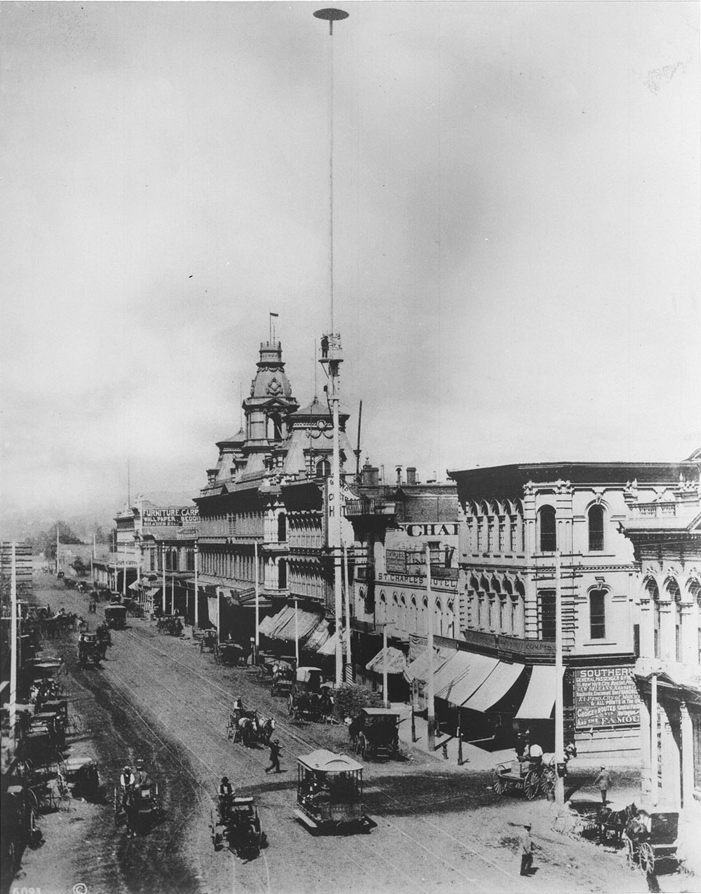 |
|
| (ca. 1882)** - Another look at one of Los Angeles' first electric light poles. View is of the buildings on the east side of North Main Street from the Ducommun Building at Commercial Street (right) to the Baker Block at , at near right, to looking toward the Baker Block at . A man can be seen standing on a platform half way up the street light mast. Click HERE to see more in Early Los Angeles Street Lights |
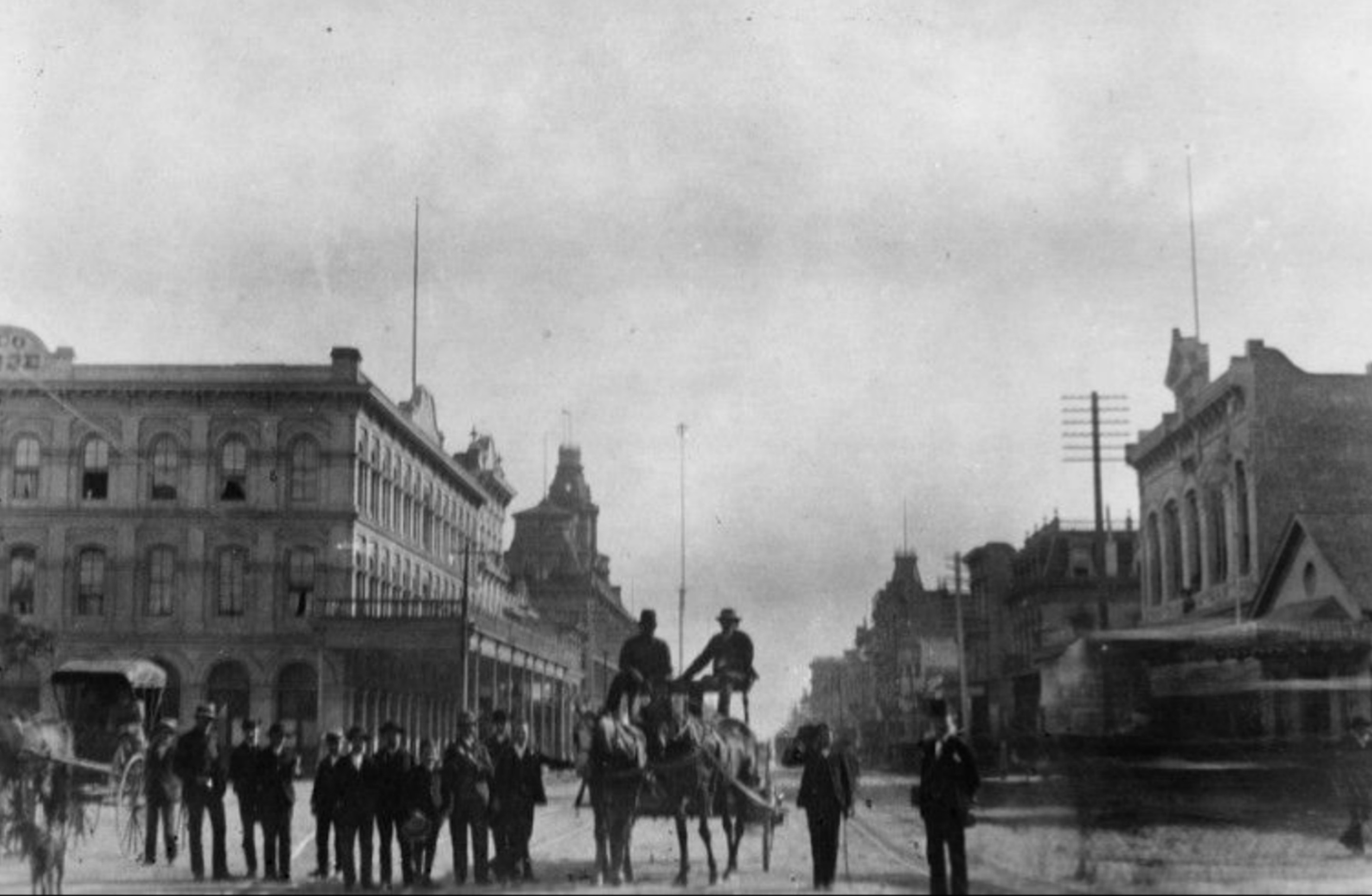 |
|
| (1883)* - View looking south on Main Street showing a group of men standing next to a horse-drawn wagon with two men seated on top. The Plaza is on the left (out of view). In the left background stands the Pico House and the Baker Block with its distinctive towers. There is a very tall pole seen between the two men on the wagon which appears to be a flagpole, but is not. It is a 150-foot tall electric street light mast that was one of the first to be installed in the City of Los Angeles. |
Historical Notes In 1882, C. L. Howland installed seven 150-foot tall streetlight masts, each carrying three carbon-arc lamps of three thousand candle-power. He also installed a small power plant to provide the electricity for his new street light system. The following year Howland and other investors would go on to form the Los Angeles Electric Company. It was the first electric utilty in Los Angeles. Click HERE to see more on LA's first electric streetlights. |
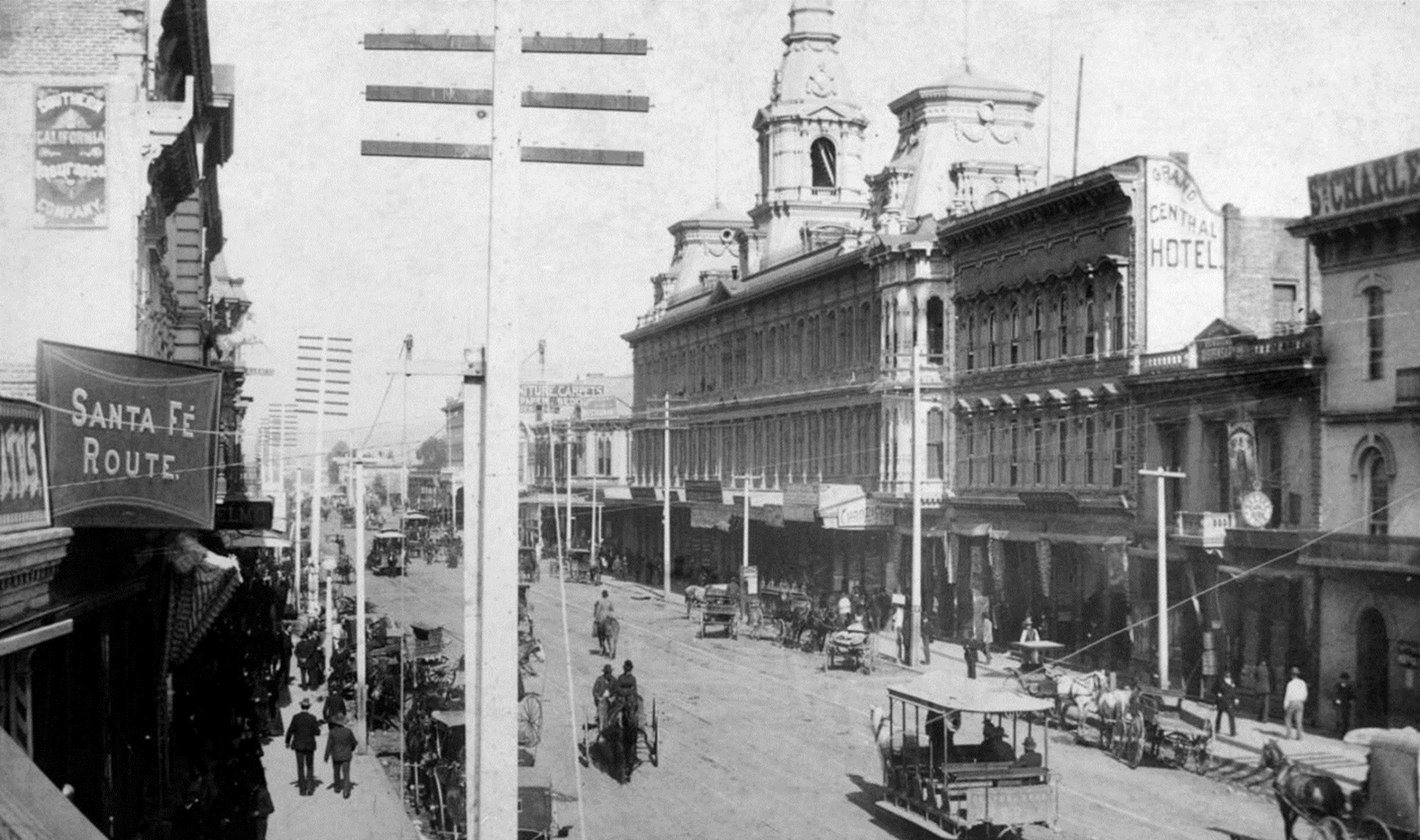 |
|
| (1888)* – View looking north on the 300 block of Main Street, filled with horse-drawn streetcars, wagons, and a lone horseback rider. To the right are the ornate Baker Block, Downey Building, Grand Central Hotel, the two-story Pico Building, and the St. Charles Hotel (formerly the Bella Union Hotel). |
Historical Notes In 1888, the 300 block of North Main Street was a bustling hub at the heart of Los Angeles' commercial district, reflecting the city’s rapid transformation. Once considered the uptown commercial center, it featured a mix of hotels, banks, and other businesses, including the Farmers & Merchants Bank in the Pico Building, Los Angeles' first incorporated bank. Horse-drawn streetcars dominated the busy streets, while the introduction of telephones and telegraphs showcased the city’s embrace of new communication technologies. As the population surged from 11,183 in 1880 to 50,395 by 1890, the area became a focal point for expanding transportation networks and new neighborhoods, symbolizing Los Angeles’ shift from a small town to a thriving metropolis. |
 |
|
| (n.d.)* - Drawing of North Main Street, showing the location of the businesses in the entire 300 block, starting with the Baker Block on the left and extending to the Duccomun Building on the right. |
 |
|
| (ca. 1890)* – Looking south on Main Street with the Baker Block on the left, distinguished by its turrets. Pedestrians walk along the sidewalk, while horse-drawn carriages and a streetcar travel on the cobblestone street. |
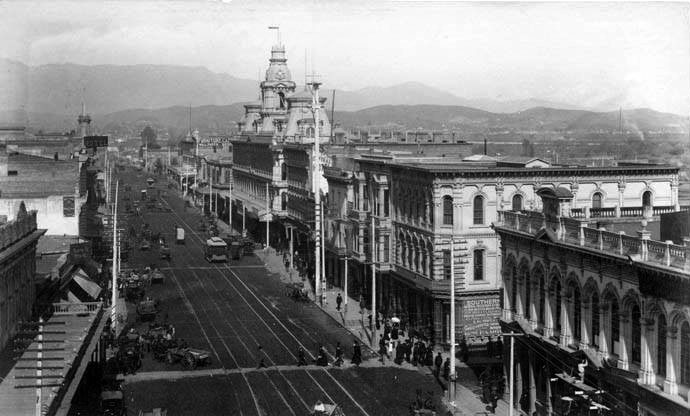 |
|
| (1898)*** - Postcard view of the 300 block of Main Street looking north on a clear day. Pedestrians are seen crossing the streetcar tracks on Main Street in front of the Ducommun Building. |
Historical Notes By the 1890s, as a result of the business center’s continuous southward expansion, North Main Street was beginning to fall into a long, slow decline. On the other hand, its tightly knit blocks were left largely untouched by new development while they continued to support active commercial uses. |
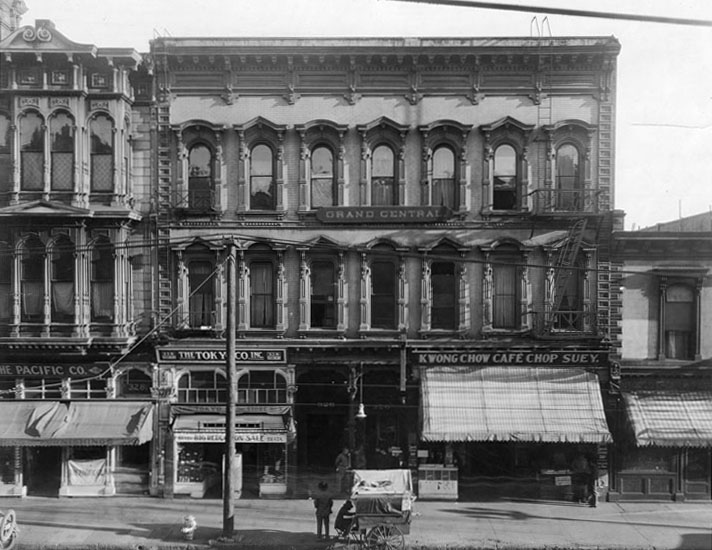 |
|
| (ca. 1910s)* - View showing the Grand Central Hotel, at 326 N. Main Street, with businesses on the ground floor such as Tokyo Co. Inc. and Kwong Chow Cafe. A man in a push cart is directly in front. To the left ia the 3-story Downey Building and further to the left (out of view) is the Baker Block. To the right is the 2-story Pico Building. |
 |
|
| (1920s)* - View showing the east side of the 300 block of N. Main Street, north from the corner of Commercial Street. The Ducommun Building is seen at right with the 'Medical Offices' sign on its face and the St. Charles Hotel is at far left. Other business establishments seen in photo include the New Queen Restaurant, La Perla de Occidente Restaurant, a pool room, and clothing shops. |
 |
|
| (ca 1926)* – View showing several people crowded on the sidewalk in front of the St. Charles Hotel (old Bella Union Hotel) on N. Main Street. The New Queen Restaurant occupies the first floor of the hotel. |
Historical Notes Constructed in 1835, the Bella Union Hotel has a long, rich history. It served as the County Courthouse until October 1851, and in 1860 was the location of a champagne fete celebrating the connection of San Francisco and Los Angeles by telegraph. |
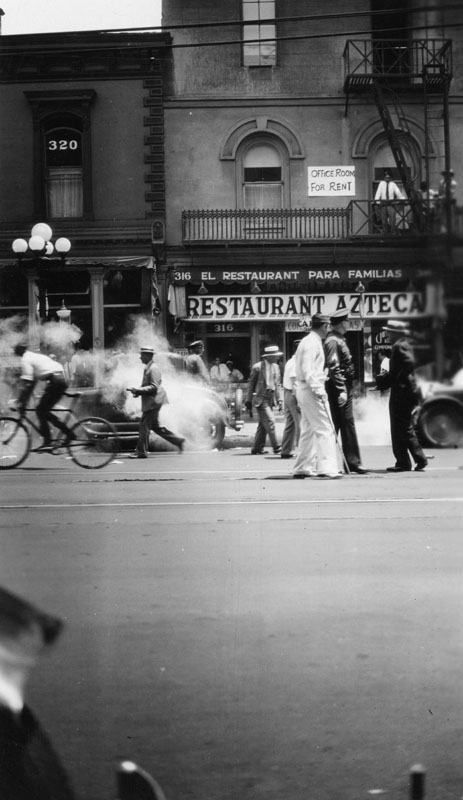 |
|
| (1920s)* - View of a busy North Main Street in front of the Azteca Restaurant, El Restaurant Para Familias', as seen from across the street. The restaurant, which in previous photo was the New Queen Restaurant, is located on the street floor of the old Bella Union Hotel. A sign on the second floor reads: Office Room For Rent. |
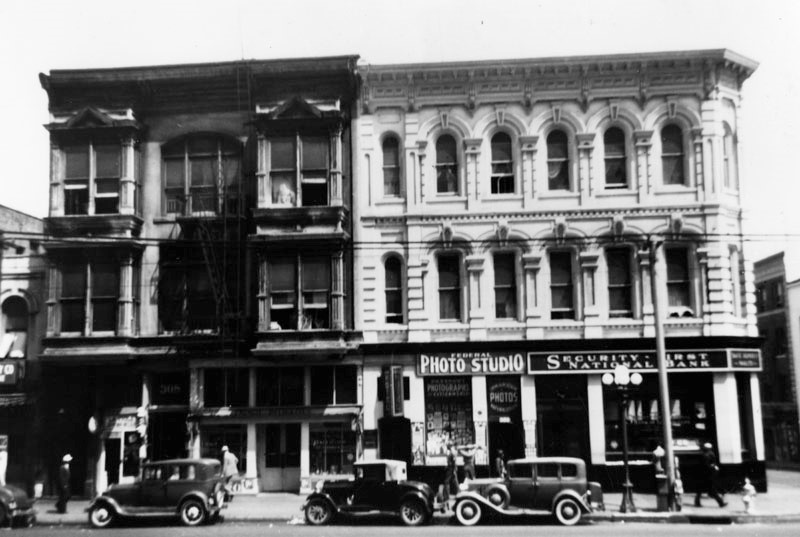 |
|
| (ca. 1930)* – View of the west side of North Main Street. Security First National Bank now occupies part of the Ducommun Building on the northeast corner of Main and Commercial streets. |
Historical Notes The Security First National Bank of Los Angeles became the Security Pacific National Bank and is now Bank of America. The Farmers and Merchants Bank was the oldest bank in Southern California from 1871 until 1956 when it was merged into the Security First National Bank of Los Angeles. |
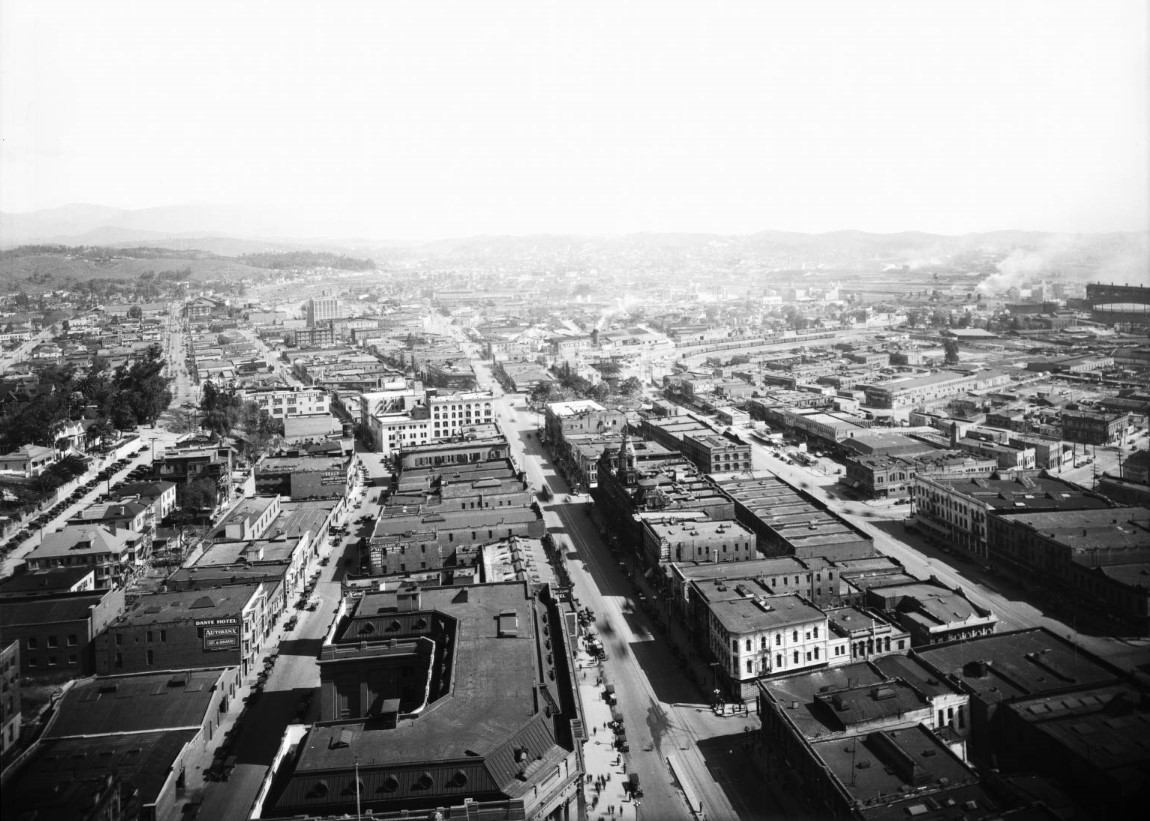 |
|
| (ca. 1930)* - Birdseye view looking north-east showing North Main Street as seen from City Hall. The large building in the foreground is the old Federal Building and Post Office (N/W corner of N. Main and Temple streets). The 300 block of Main Street is in clear view. |
.jpg) |
|
| (ca. 1930)* - Aerial view showing a closer look at the historic 300 block of North Main Street from Arcadia Street to Commercial Street. |
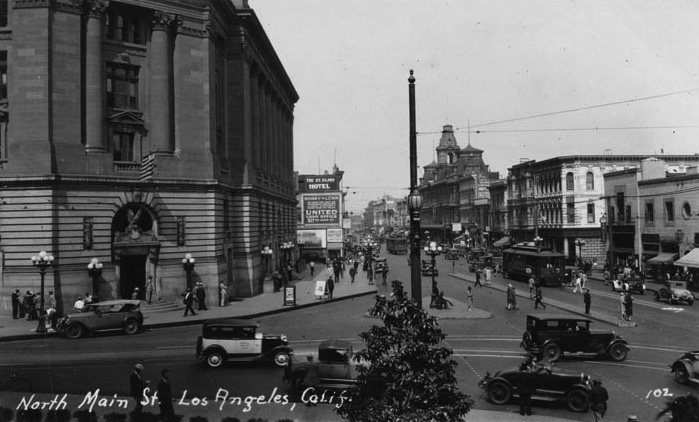 |
|
| (1932)^*# - Postcard street view of North Main Street as seen from the base of Los Angeles City Hall at Temple Street. The entire 300 block of N. Main Street, from Baker Block to the Ducommun Building, can be seen here. The old Federal Building and Post Office stands on the northwest corner. |
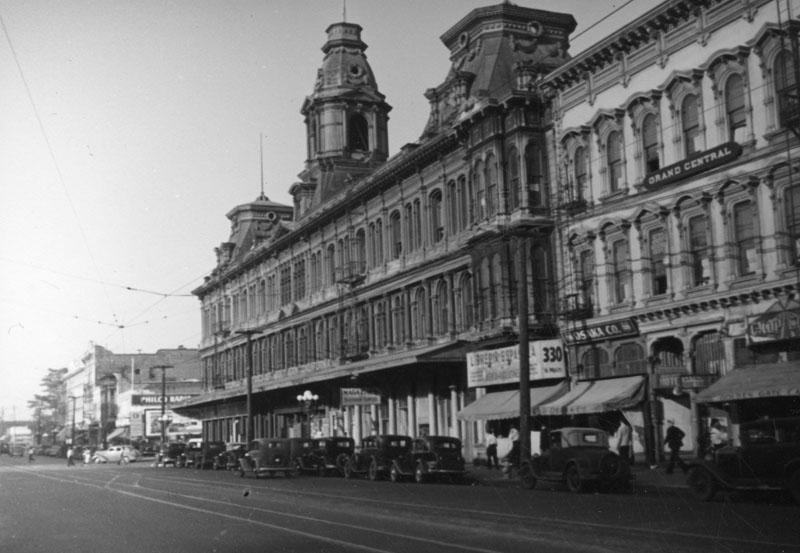 |
|
| (ca. 1936)* - Looking across N. Main Street (foreground) towards the French Second Empire style Baker Block, on the southeast corner at Arcadia Street (lower left), and the Grand Central Hotel (right). Between the two sits a very narrow Doheny Building. |
Historical Notes The Baker Block had lost much of its luster by the turn of the century, and by the time it was purchased by Goodwill Industries in 1919, it was all too clear that its days were numbered. As cruel fate would have it, the faded landmark was slated to give way to one of the most mundane projects in the 1930 Civic Center plan: a two-block extension of Aliso Street from Los Angeles Street to Broadway. Despite plans to relocate the structure for another purpose, the city purchased the Baker Block from Goodwill in 1941 and demolished the building a year later. U.S. Route 101 now runs beneath where these buildings once stood. |
 |
|
| (ca. 1940)* - Looking northeast showing the buildings on the 300 block of North Main Street shortly before their demoliton. |
Historical Notes Well into the 20th century, the old buildings on the 300 block of North Main Street were a vivid testament to Los Angeles’ early history, from its humble beginnings to its astonishing growth during the Reconstruction years. Behind the “Azteca” sign on the right side of the top photograph is the Bella Union Hotel, considered to be the city’s first hotel. Completed sometime during the 1840s, it was one of downtown’s greatest landmarks for several decades, and was later expanded to two, then three stories. The two-story building to its left is the Pico Building, built by Pio Pico in 1868 (two years before the Pico House). In 1871, the building became home to the Farmers & Merchants Bank, the first incorporated bank in the Los Angeles, directed by former California Governor John G. Downey. |
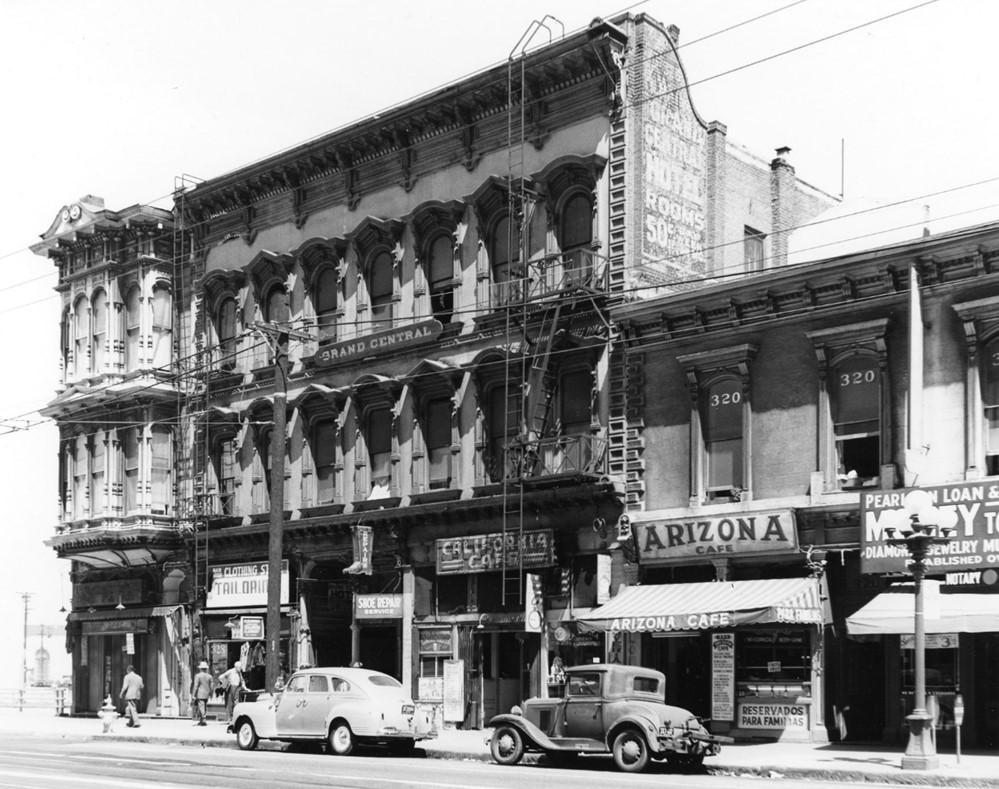 |
|
| (ca. 1949)*- View of the 300 block of North Main Street, just north of Commercial Street, showing (L to R): the slim, ornate Downey Building, the Grand Central Hotel, and the Pico Building (original home of Farmers and Merchants Bank). At the lower center-right, two rival cafes, the California Cafe and the Arizona Cafe, stand side by side—proving even eateries from neighboring states can get along... at least until lunchtime rush!". |
Historical Notes The Baker Block is missing in the image above. This prominent structure, built in 1878, was demolished in 1942. It had been one of the most impressive buildings of its time, known for its ornate French Second Empire architecture. |
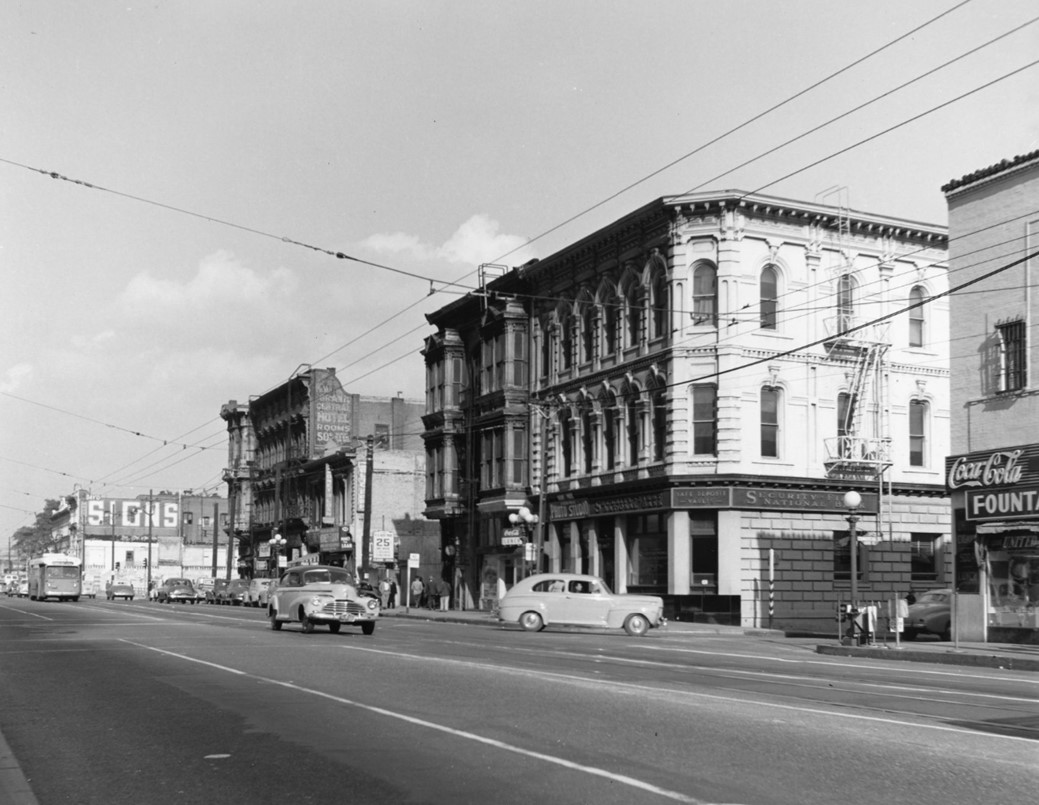 |
|
| (ca. 1949)* - Main Street, looking northeast at Commercial Street with the Ducommun Block and Security First National Bank on corner. Photo by Arnold Hylen |
.jpg) |
|
| (ca. 1950)* - View showing the last building standing on the 300 block of North Main Street awaiting demolition. It is the slim, three-story Downey Building (built in 1878) that once was nestled between the Baker Block and Grand Central Hotel. |
 |
|
| (ca. 1950)* - View looking east showing the Downey Building at 330 N. Main Street before its demise. |
Before and After
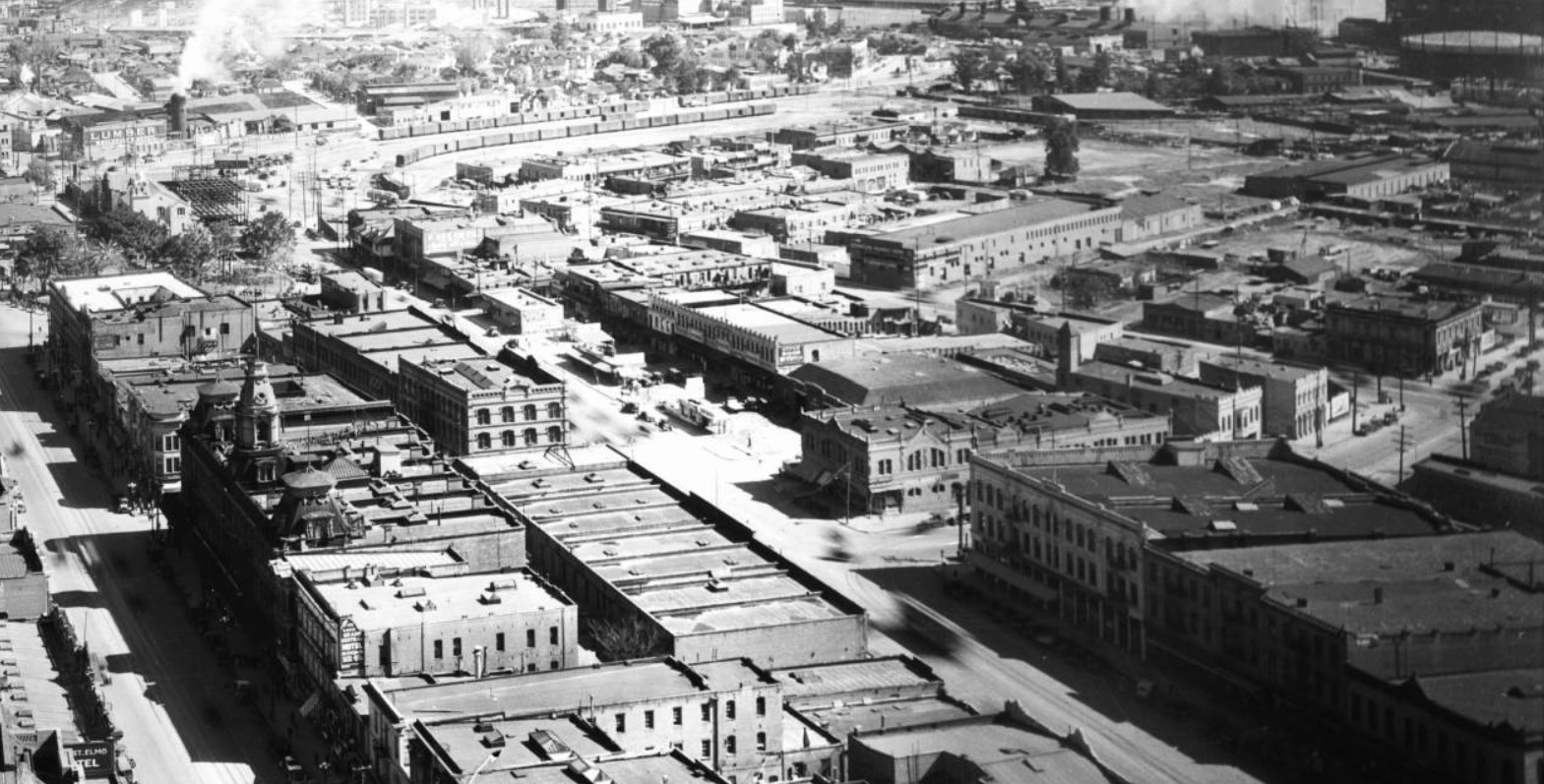 |
|
| (ca. 1930)* - View looking northeast from City Hall showing the old part of Los Angeles including the LA Plaza and Chinatown. At left can be seen the ornate Baker Building with its three towers located on the historic 300 block of N. Main Street. Los Angeles Street runs diagonally from lower-right to upper-left. Aliso Street runs from Los Angeles Street at center east and then turns diagonally up. Union Station wasn't completed until 1938 and would be located in the upper right of photo. |
Historical Notes The historic buildings on the 300 block of North Main were demolished to extend Aliso Street from Los Angeles Street to Broadway. Several years later the Hollywood Freeway (Route 101) would be constructed over this new Aliso Street extension. |
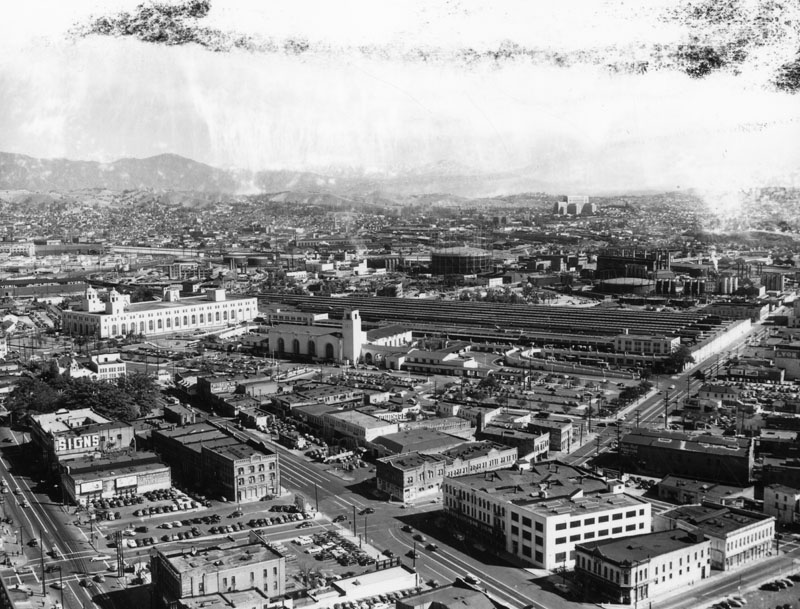 |
|
| (ca. 1951)* - Aerial view of Los Angeles near the Plaza before construction of the Hollywood Freeway with Union Station in the background. The Plaza is seen to the left. The 300 block of North Main Street is at lower left, now consisting of mostly parking lots and the new Aliso Street extension. |
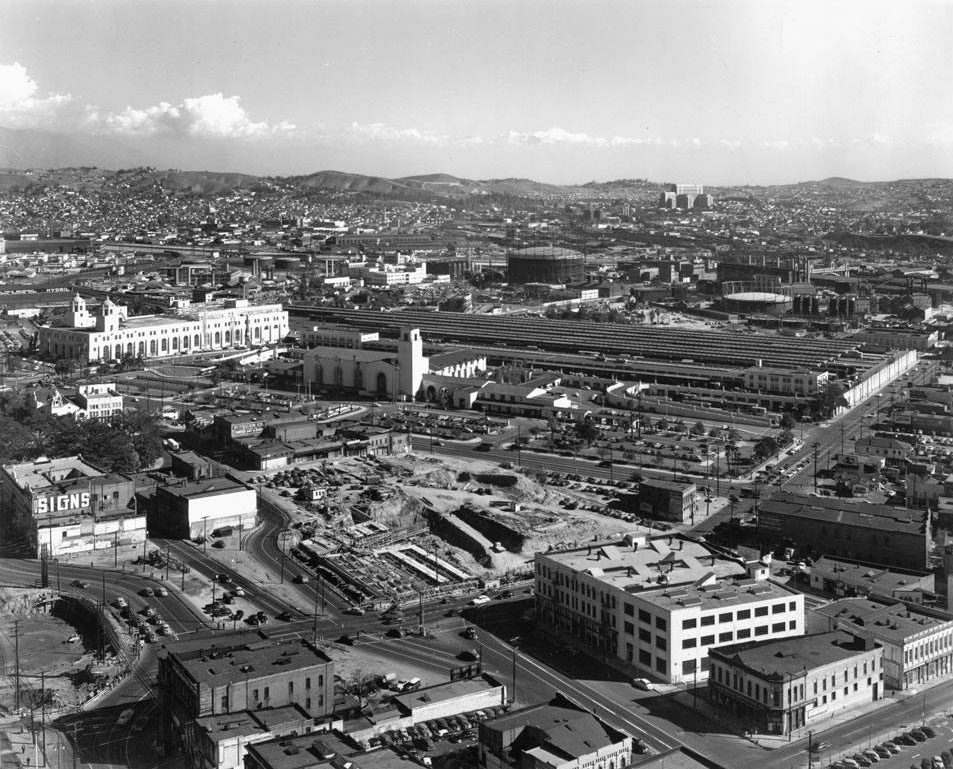 |
|
| (1950s)^^ - Construction of the 101 Freeway begins through the old section of Los Angeles along Aliso Street. The LA Plaza is seen at left-center and the historic 300 block of Main Street at lower left corner. |
Historical Notes The Hollywood Freeway (U.S. Route 101) through downtown Los Angeles was opened in 1954. |
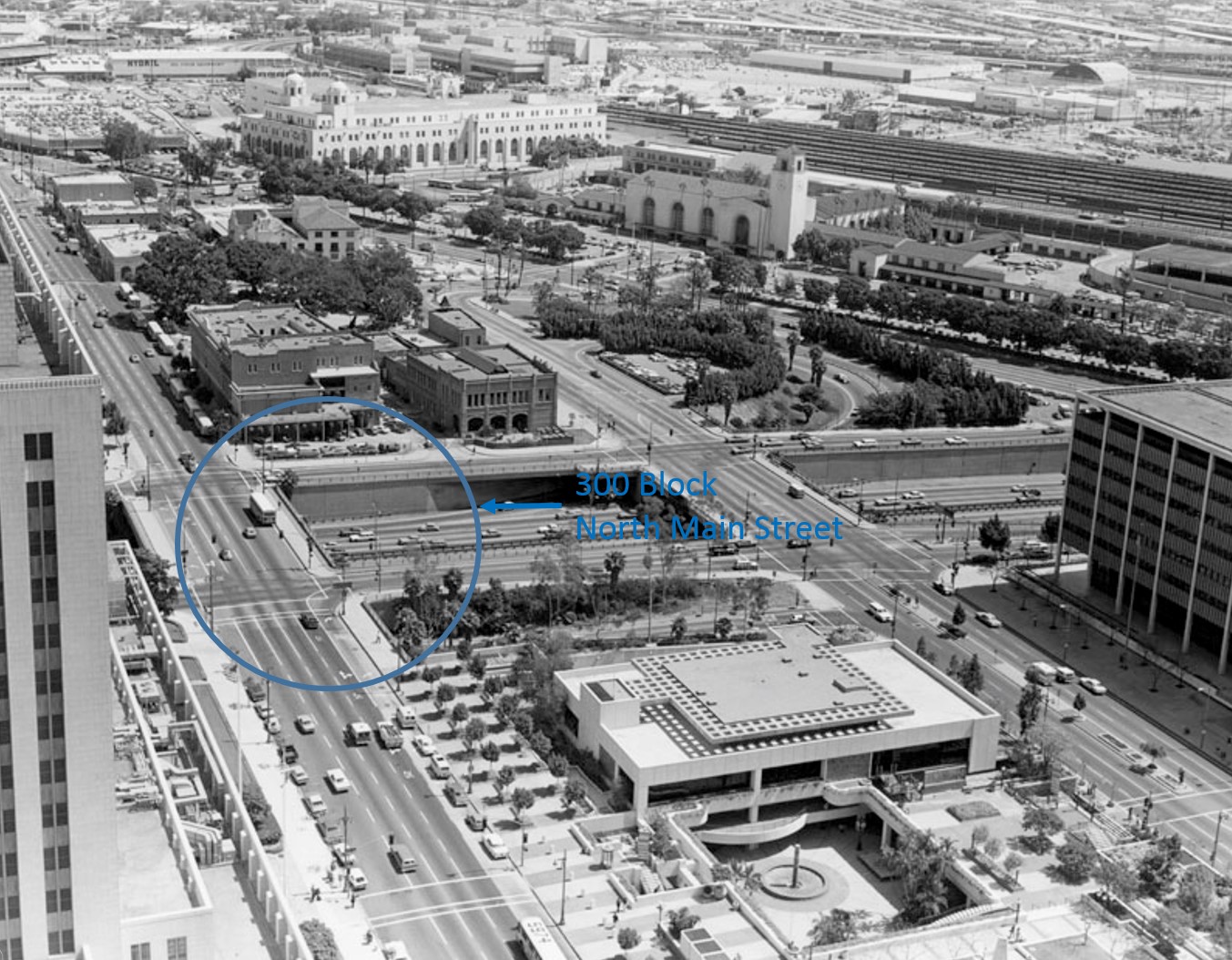 |
|
| (1970s)* - View from City Hall looking down toward the 300 block of North Main Street. The Hollywood Freeway (U.S. Route 101) now runs beneath where the Main Street historic buildings once stood. |
Then and Now
 |
|
| (1880s vs 2023)* - Looking southeast from Fort Moore Hill, the ornate Baker Block once stood on the southeast corner of Main and Arcadia Streets. Today, the 101 Freeway runs beneath the site of this historic building. Photo comparison by Jack Feldman. |
Historical Notes The Baker Block, constructed in 1878 by Colonel Robert S. Baker, was one of the grandest commercial buildings of its era, featuring a striking French Second Empire design and an early use of steel framing. It housed high-end apartments, shops, and offices and was once considered the finest building south of San Francisco. By 1942, the building had been demolished to make way for the US 101 Freeway, which now runs beneath the site, erasing a cornerstone of early downtown Los Angeles. |
Then and Now
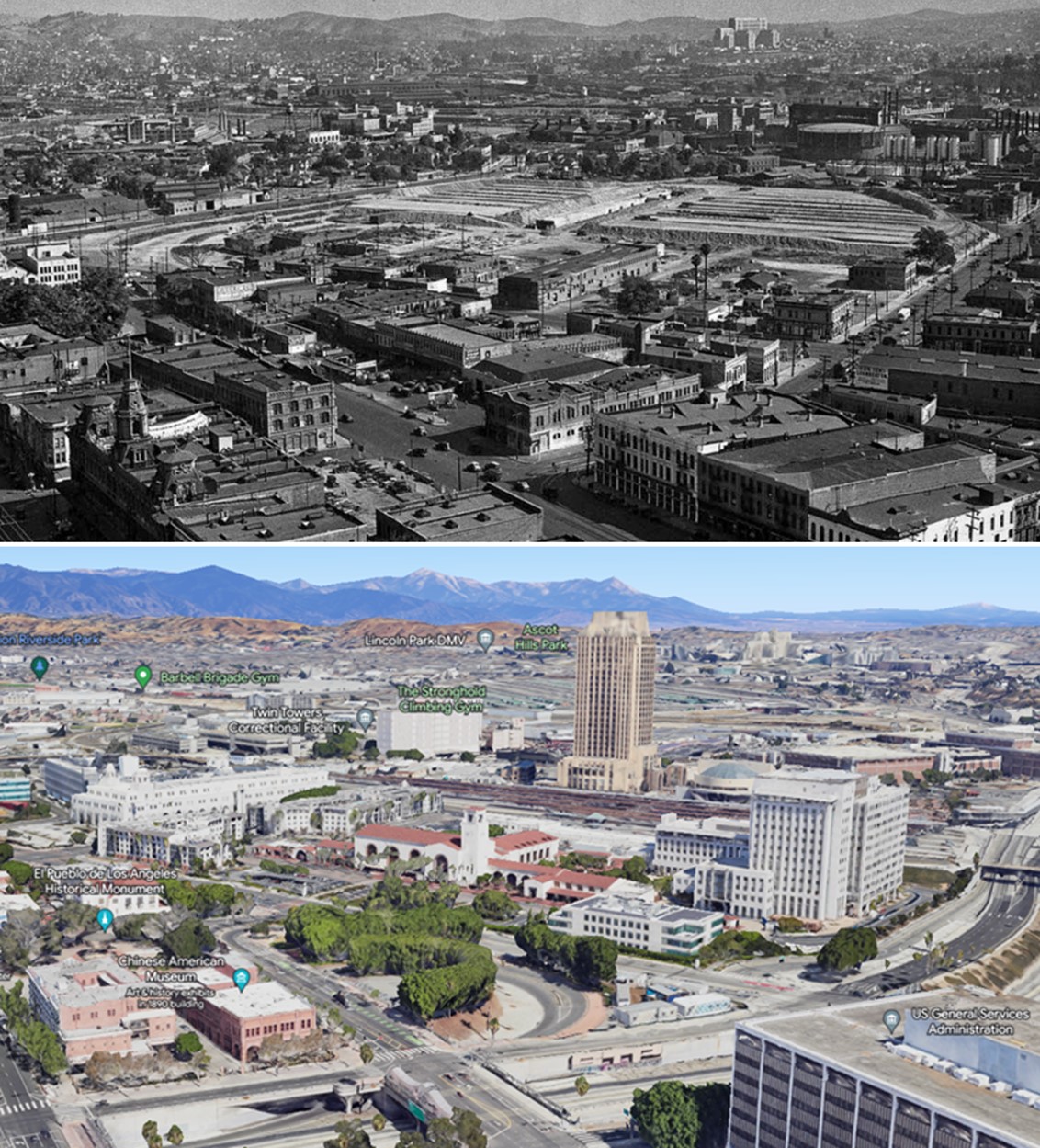 |
|
| (1935 vs 2022)* - Looking down toward Union Station from the top of City Hall. Note the Hollywood Freeway runs through where the Baker Block once stood (lower-left). Photo comparison by Jack Feldman. |
Historical Notes The 1935 photo shows the Los Angeles Plaza area in transition, as the old neighborhood was being cleared to build Union Station, which opened in 1939. In the lower left, the Baker Block stood shortly before its demolition for the Hollywood Freeway. This view highlights how rail and highway projects of the mid-20th century dramatically reshaped the city’s historic core. |
Main Street Through the Years: Then and Now
.jpg) |
|
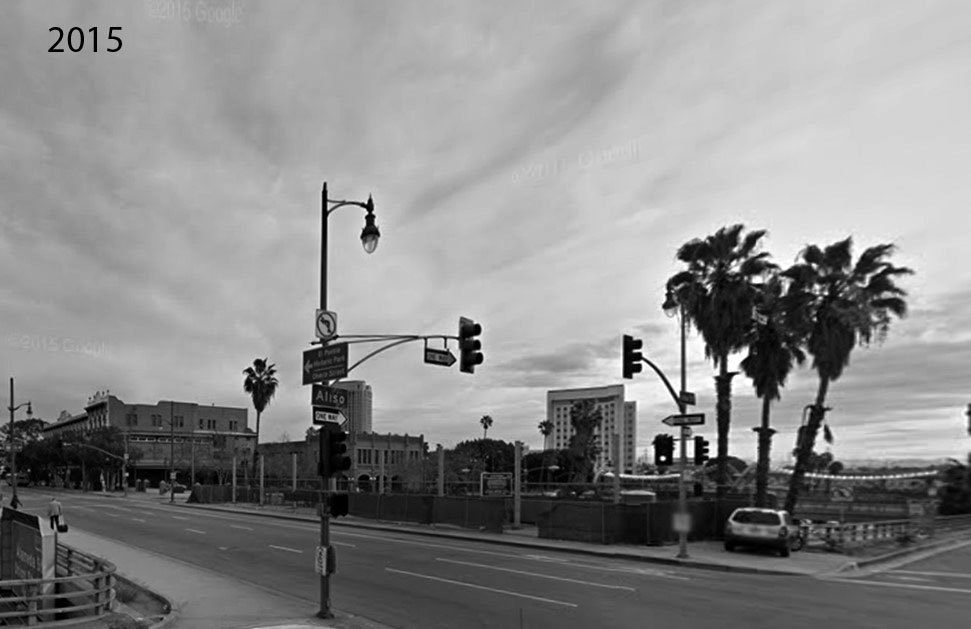 |
|
| (1930s vs 2015)* - View of N. Main Street as seen from about the same spot over 70 years later. Photo comparison by Jack Feldman. |
Historical Notes In the 1930s, North Main Street retained much of its 19th-century character, with commercial storefronts and historic hotels like the Bella Union still in place. By 2015, modern infrastructure and redevelopment had stripped away nearly all of the original streetscape, leaving only fragments of early Los Angeles visible near the Plaza. |
Then and Now
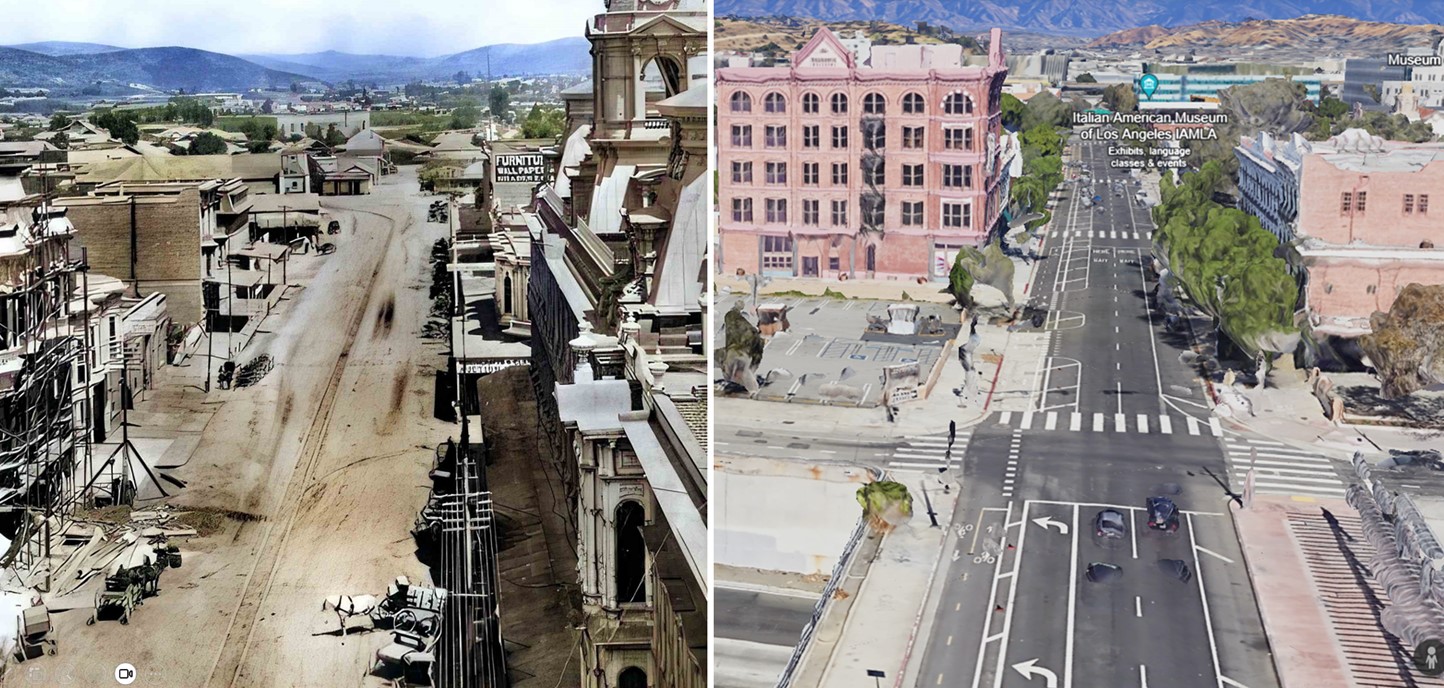 |
|
| (1880 vs 2022)* - Looking north on the 300 Block of Main Street. Photo comparison by Jack Feldman. |
Historical Notes The 300 block of Main Street once featured some of Los Angeles’ most important early buildings, including the Bella Union Hotel and the Pico Building, which housed the Farmers and Merchants Bank. This stretch of Main was the city’s commercial heart in the late 1800s. Today, none of the original buildings remain, replaced by civic infrastructure and widened roadways. |
* * * * * |
Main Street Through the Years: Then and Now
 |
|
| (1870 vs 2022)* – Looking north on Main Street from Aliso Street in Old Downtown Los Angeles. Homeless tents line the sidewalks in the 2022 view, a stark contrast to the open dirt road of 1870. Photo comparison by Jack Feldman. |
Historical Notes This “Then and Now” comparison shows Main Street as it appeared in 1870 (top) and in 2022 (bottom). The 1870 photo captures a dirt road leading north toward the recently completed Pico House, barely visible across from the Los Angeles Plaza. To the right stands the Bella Union Hotel, a prominent landmark of early Los Angeles. By 2022, the historic streetscape had changed dramatically—most of the buildings on this stretch were demolished in the 1950s for the 101 Freeway, which now runs beneath the Main Street overpass. In the modern view, homeless encampments line the sidewalks, reflecting Los Angeles’ ongoing challenges with housing and public space. The prominent brick building in the frame is the Merced Theatre, partially obscuring the Pico House from this angle. |
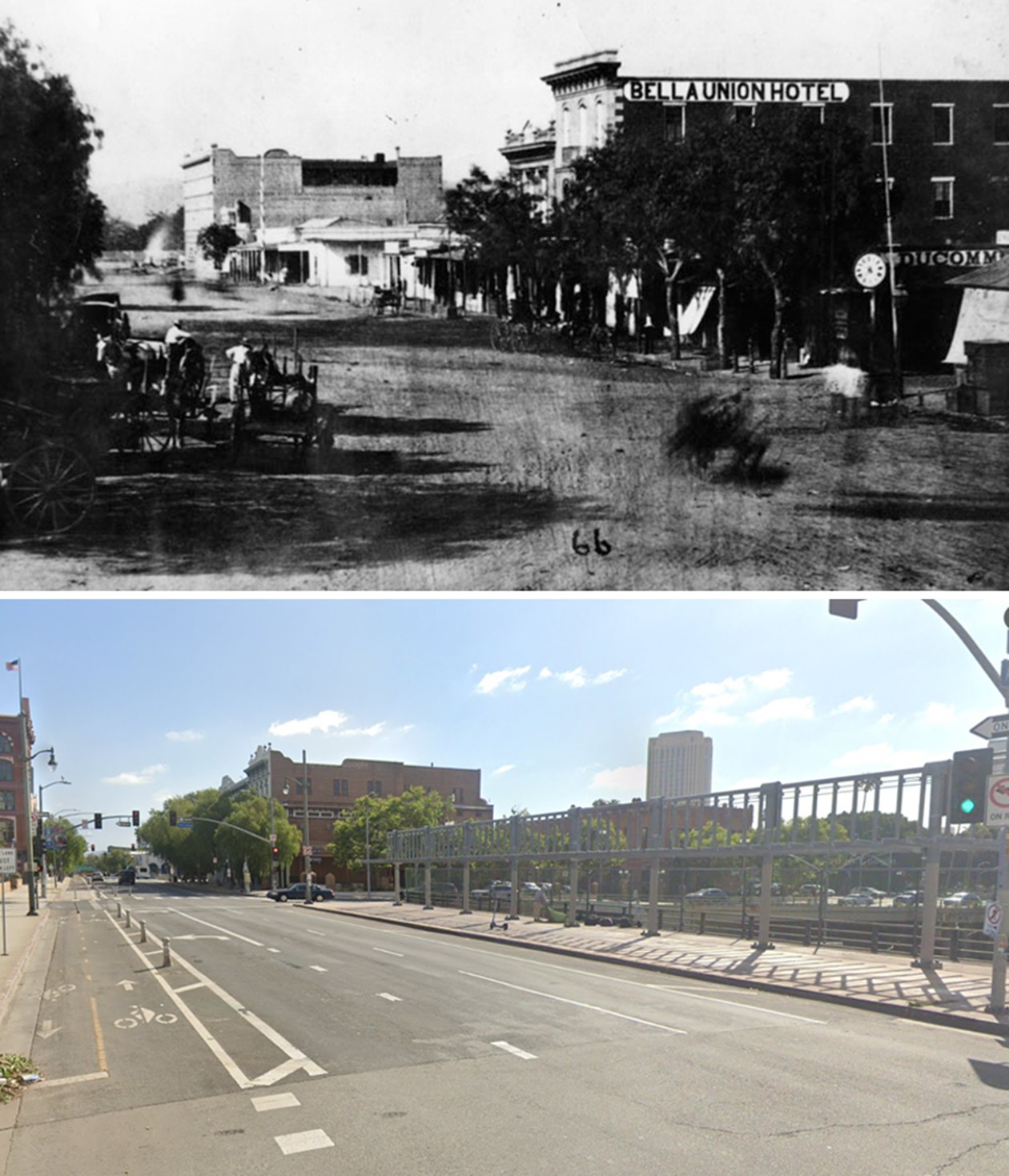 |
|
| (1870 vs. 2025)* – Main Street looking north from Aliso Street in Old Downtown Los Angeles. The 2025 view shows the sidewalks clear of tents, offering a cleaner and more open public space. Photo comparison by Jack Feldman. |
Historical Notes This updated comparison revisits the same vantage point as the 2022 image. By 2025, the homeless tents previously lining Main Street have been removed, restoring a sense of openness to this historic corridor. Whether through city outreach efforts, service programs, or encampment relocation, the area now offers a clearer view of the surviving landmarks, including the Merced Theatre and the Pico House in the distance. While it’s uncertain if this improvement will endure, the contrast between 2022 and 2025 underscores the city’s ongoing struggle—and hope—to balance historic preservation, urban life, and humanitarian challenges. |
Then and Now
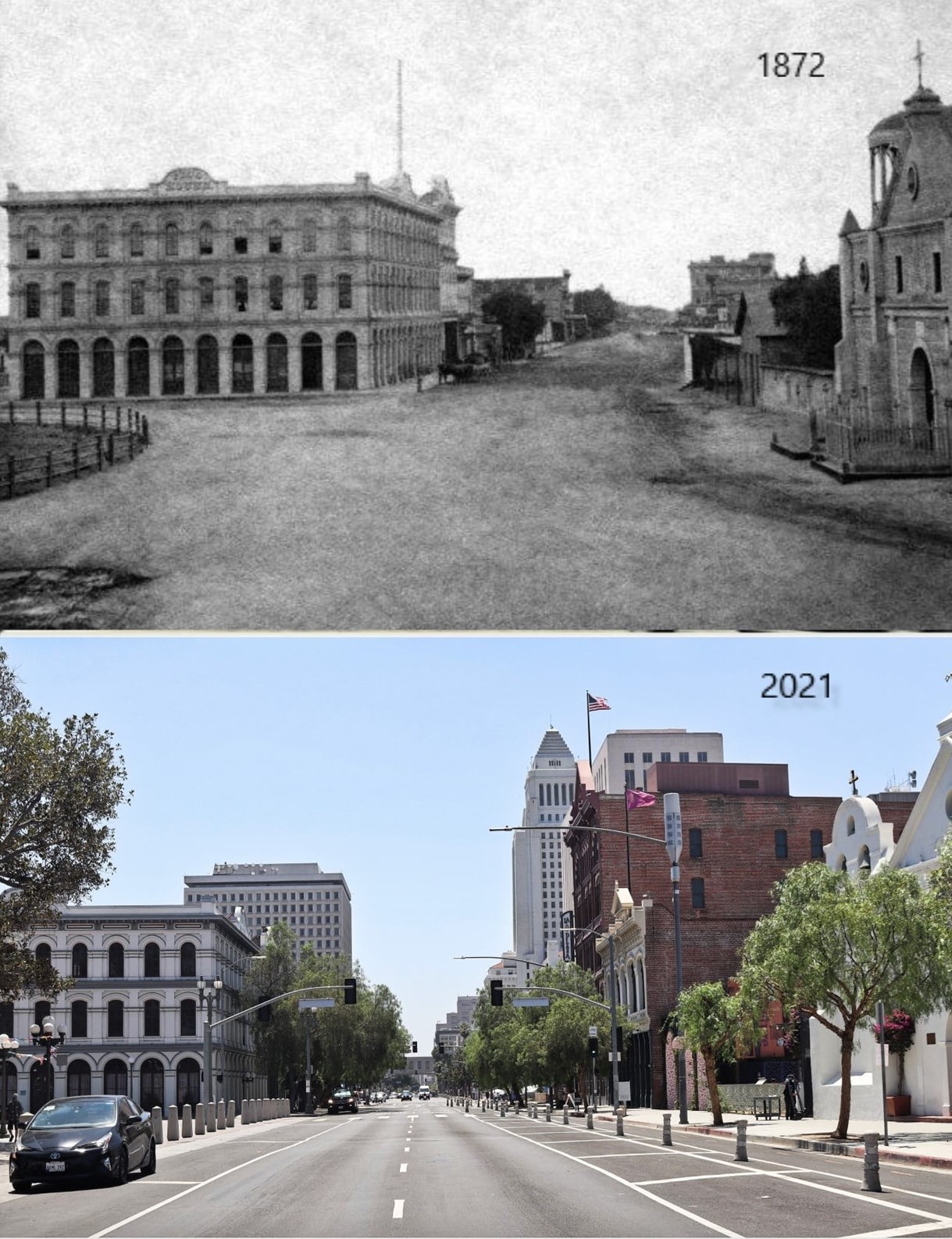 |
|
| (1872 vs 2021)* – Looking south on Main Street from in front of the LA Plaza. Three buildings still exist today: The Pico House and the Merced Theatre on the left, and the Plaza Church on the right. In the distance of the early photo can be seen the Temple Block, current site of Los Angeles City Hall. Photo courtesy of Mark Frazier. |
Historical Notes The 1872 photo shows three historic landmarks still standing today: the Pico House and Merced Theatre on the left, and the Plaza Church on the right. In the distance, the Temple Block marked the commercial hub of the early city and would later be replaced by City Hall. This pairing highlights how rare it is for 19th-century structures to survive in downtown Los Angeles. |
Then and Now
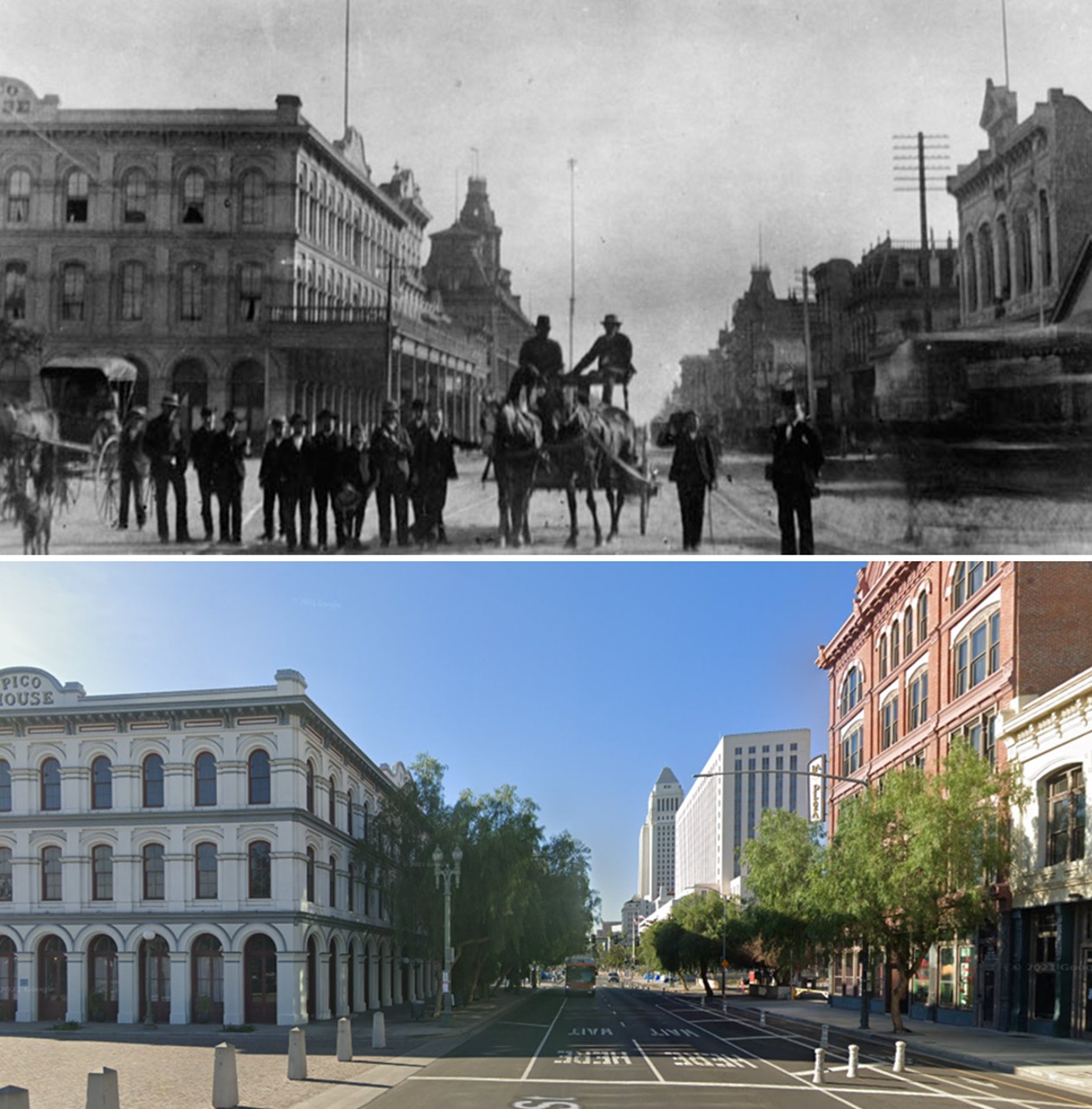 |
|
| (1883 vs. 2021)* – A ‘Then and Now’ view looking south on Main Street from in front of the Los Angeles Plaza with the Pico House on the left. Photo comparison by Jack Feldman. |
Historical Notes In 1883, Main Street around the Plaza was still the city’s social and commercial center, with the Pico House and Merced Theatre dominating the view. By 2021, the Plaza area remains one of the few places where these early structures coexist with the modern civic skyline, offering a direct link to Los Angeles’ pre-railroad past. |
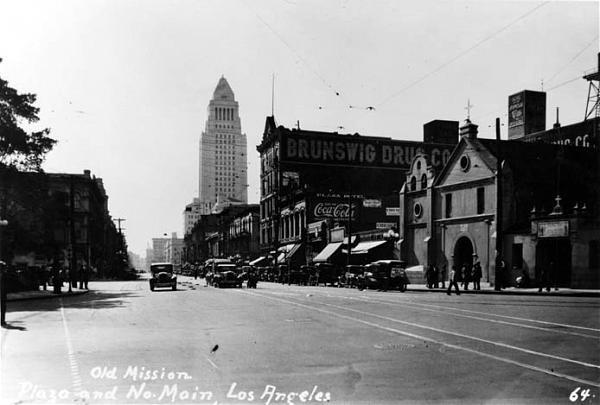 |
|
| (ca. 1928)* - View looking south on Main Street showing the newly constructed City Hall standing in the background (corner of Temple and Main streets) with the Brunswig Building and Old Plaza Church at right. |
Historical Notes This 1928 image captures the newly completed Los Angeles City Hall in the distance, rising above the Temple and Main Street intersection. On the right are the Brunswig Building and Old Plaza Church, both of which date back to the late 19th century. This was a pivotal moment as City Hall became the focal point of the growing metropolis. |
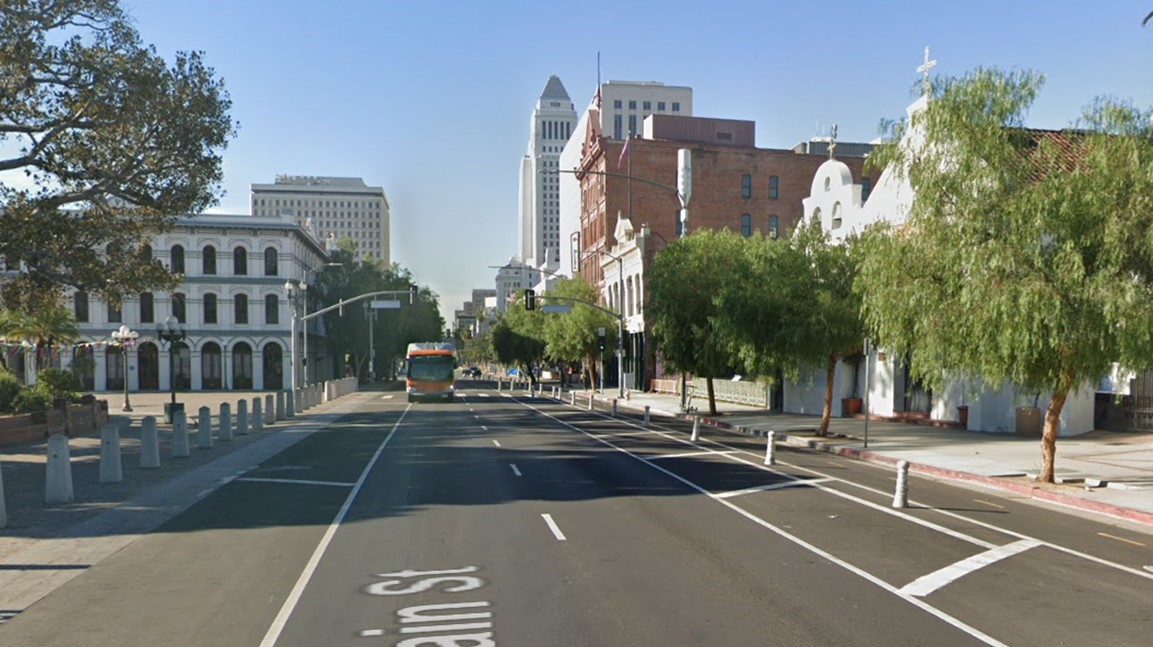 |
|
| (2021)* - Contemporary view looking south on Main Street from in front of the Los Angeles Plaza, with the Old Plaza Church visible on the right. Notable buildings from left to right include the Pico House, City Hall East, City Hall, the Federal Courthouse, the Vickrey/Brunswig Building, and the Plaza House. |
Historical Notes The modern view from in front of the Plaza shows how downtown Los Angeles has evolved while still preserving key historic buildings. From left to right, the Pico House, City Hall East, City Hall, the Federal Courthouse, the Vickrey/Brunswig Building, and the Plaza House frame the street. The contrast between 19th-century brick structures and 20th-century civic towers reflects over 150 years of city growth. |
Then and Now
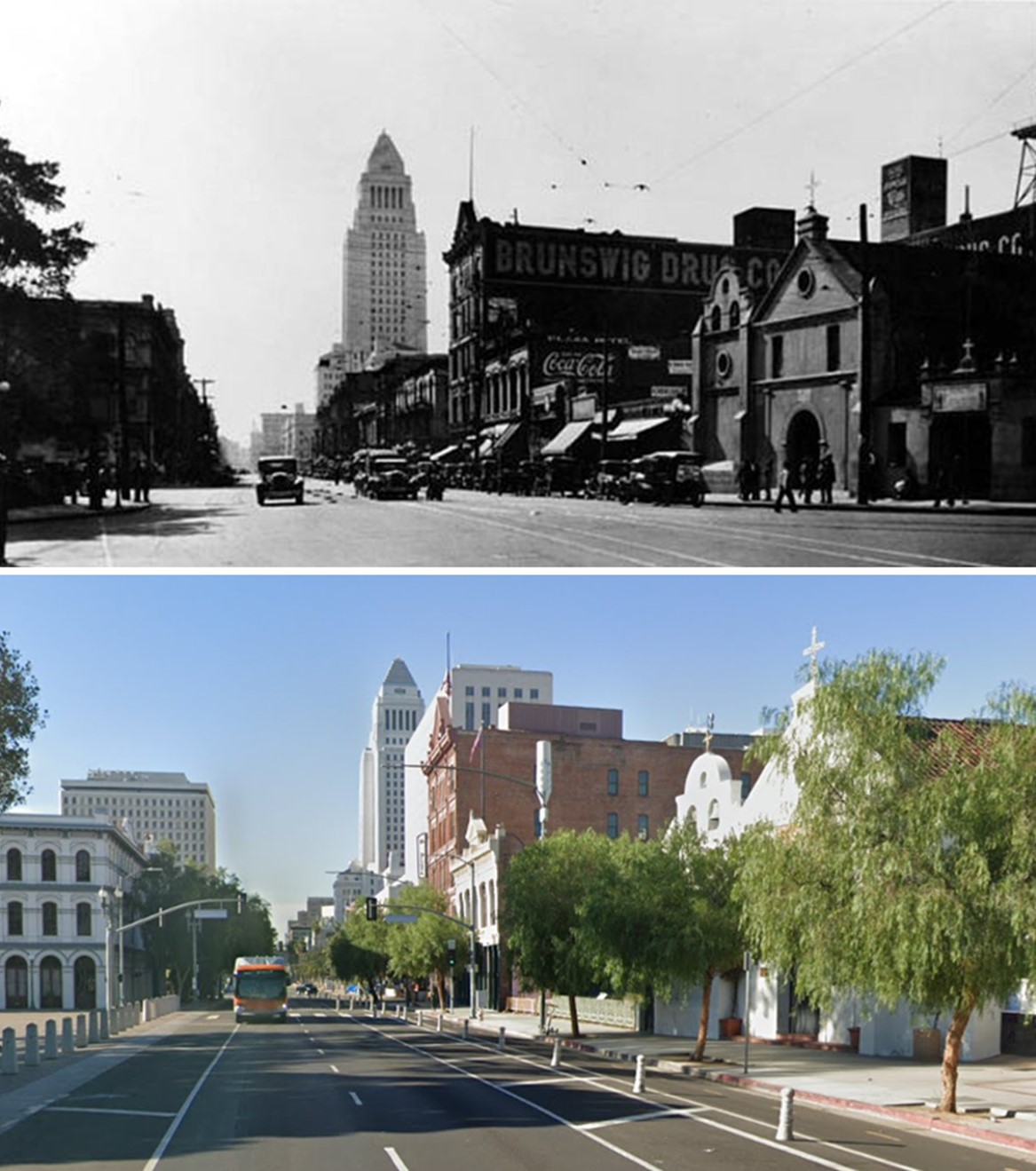 |
|
| (1928 vs. 2021)* – Looking south on Main Street from in front of the Los Angeles Plaza, with the Old Plaza Church visible on the right. Most of the buildings seen in the 1928 photo still stand today. The only additions visible in the contemporary photo are the Federal Courthouse (1940) and City Hall East (1969). Photo comparison by Jack Feldman. |
Historical Notes The 1928 photo, taken just after City Hall’s completion, shows how much of the Plaza-area architecture remains intact today. The Old Plaza Church, Pico House, Vickrey/Brunswig Building, and Plaza House are still standing, though newer additions like the Federal Courthouse (1940) and City Hall East (1969) now dominate the skyline. |
* * * * * |
Please Support Our CauseWater and Power Associates, Inc. is a non-profit, public service organization dedicated to preserving historical records and photos. Your generosity allows us to continue to disseminate knowledge of the rich and diverse multicultural history of the greater Los Angeles area; to serve as a resource of historical information; and to assist in the preservation of the city's historic records.
|
More Historical Early Views
Newest Additions
Early LA Buildings and City Views
History of Water and Electricity in Los Angeles
* * * * * |
References and Credits
* LA Public Library Image Archive
** DWP - LA Public Library Image Archive
++Vigilantism in Los Angeles (1853 - 1874)
***Photos of Vintage Los Angeles: Facebook.com
*^*California Historical Landmarks Listing (Los Angeles)
^*^Urban Diachrony: East side of North Main Street south of Arcadia Street
^*#California State Library Image Archive
*^ Wikipedia: Farmers and Merchants Bank of Los Angeles; Isaias Wolf Hellman
< Back
Menu
- Home
- Mission
- Museum
- Major Efforts
- Recent Newsletters
- Historical Op Ed Pieces
- Board Officers and Directors
- Mulholland/McCarthy Service Awards
- Positions on Owens Valley and the City of Los Angeles Issues
- Legislative Positions on
Water Issues
- Legislative Positions on
Energy Issues
- Membership
- Contact Us
- Search Index